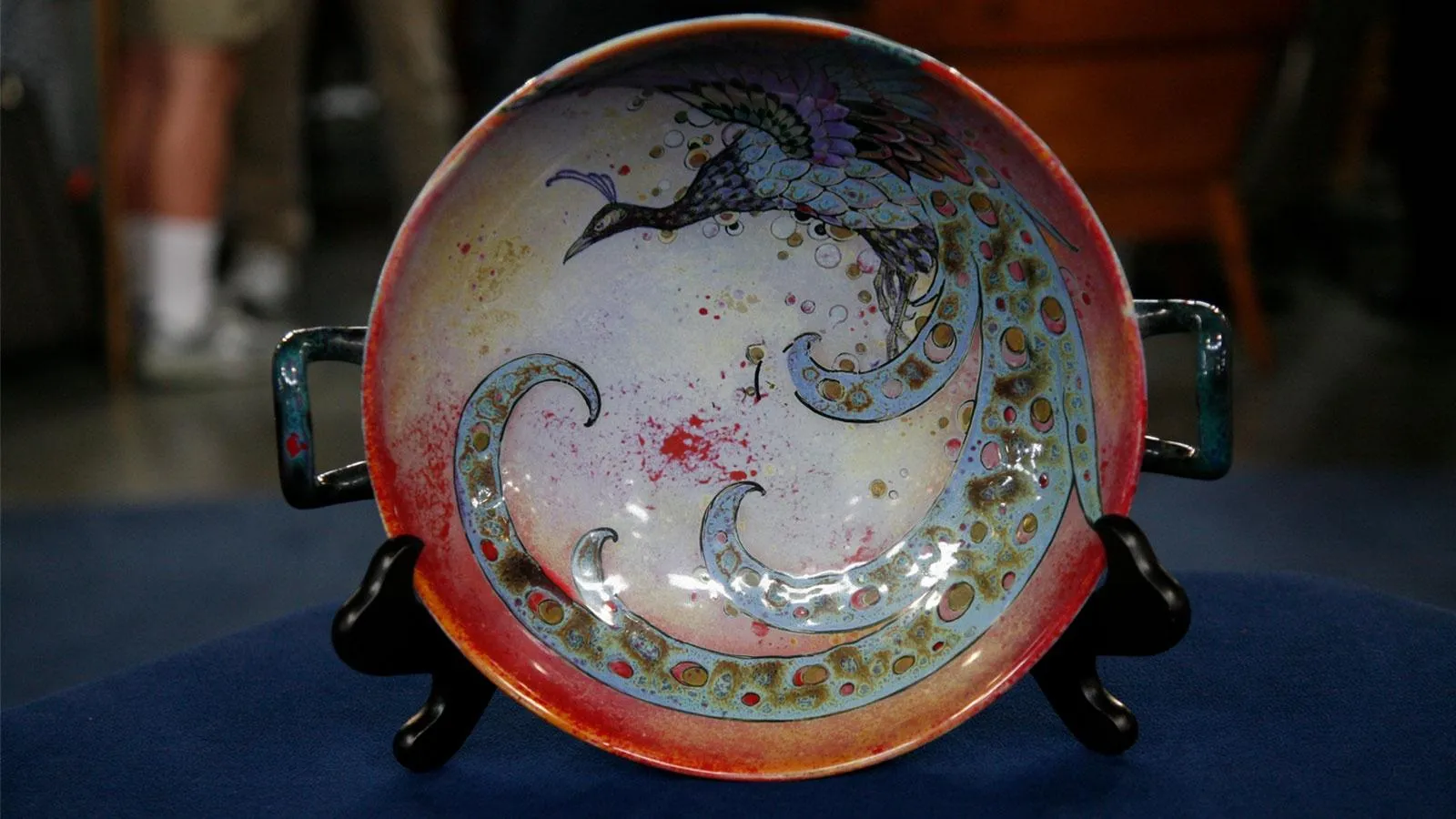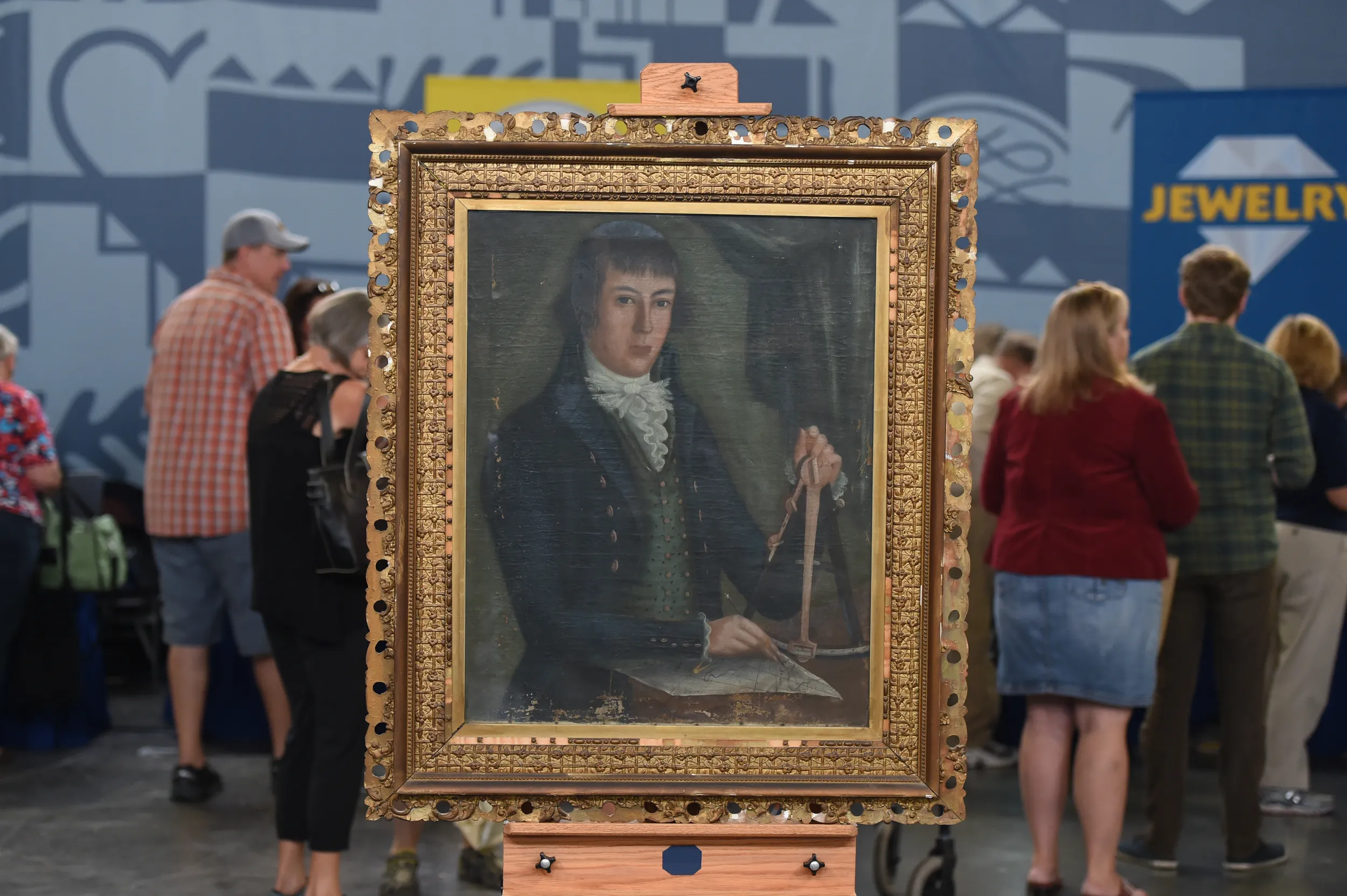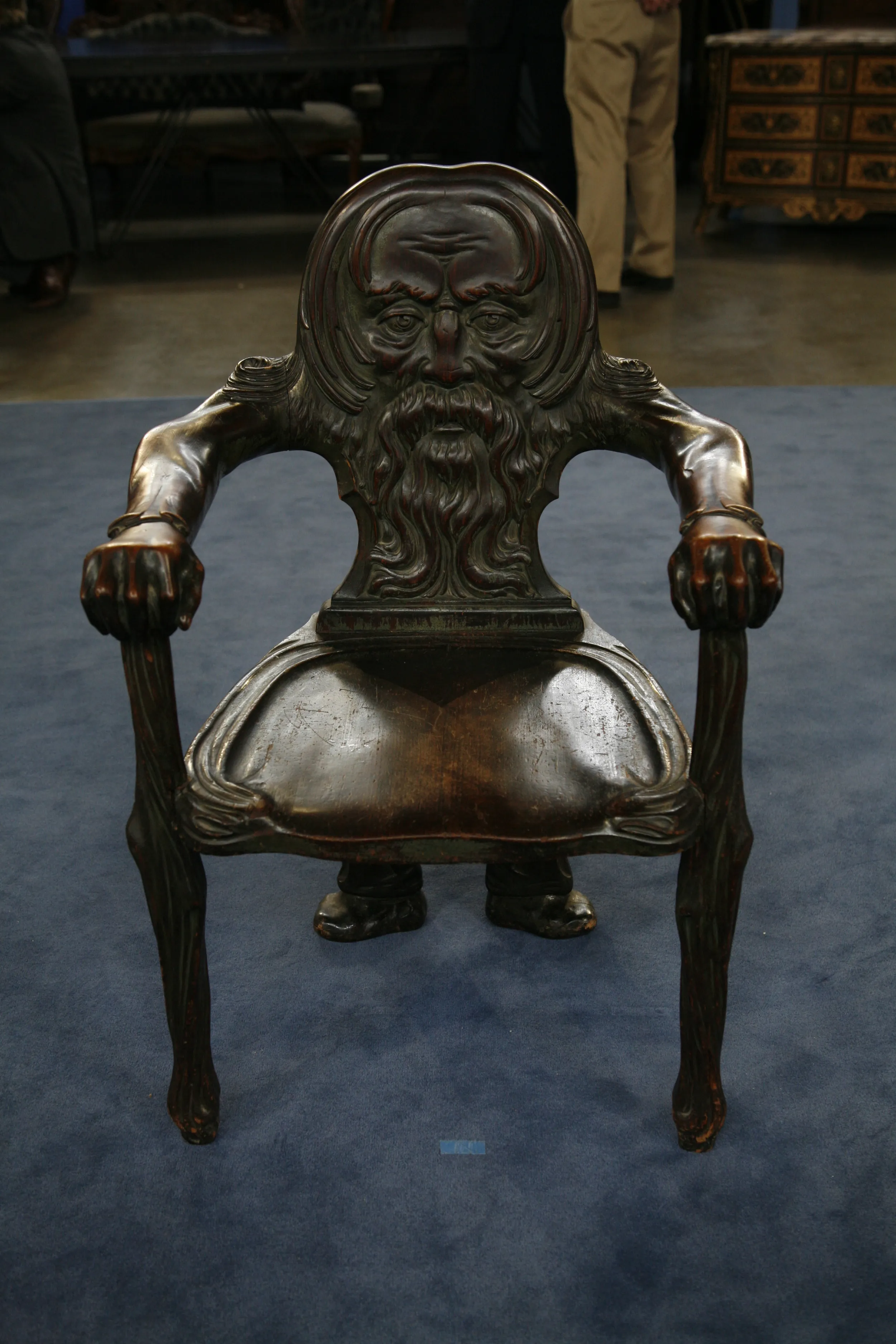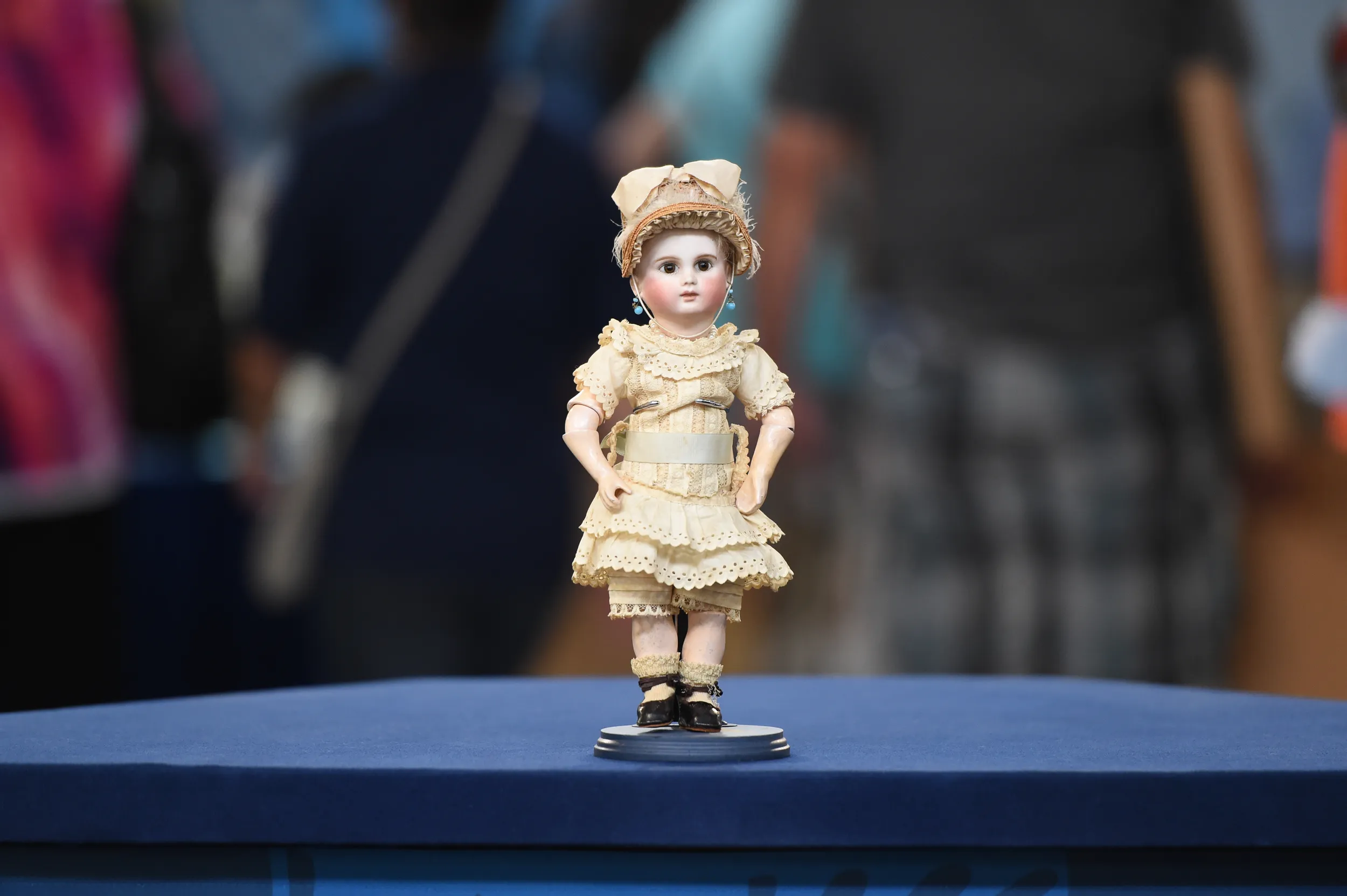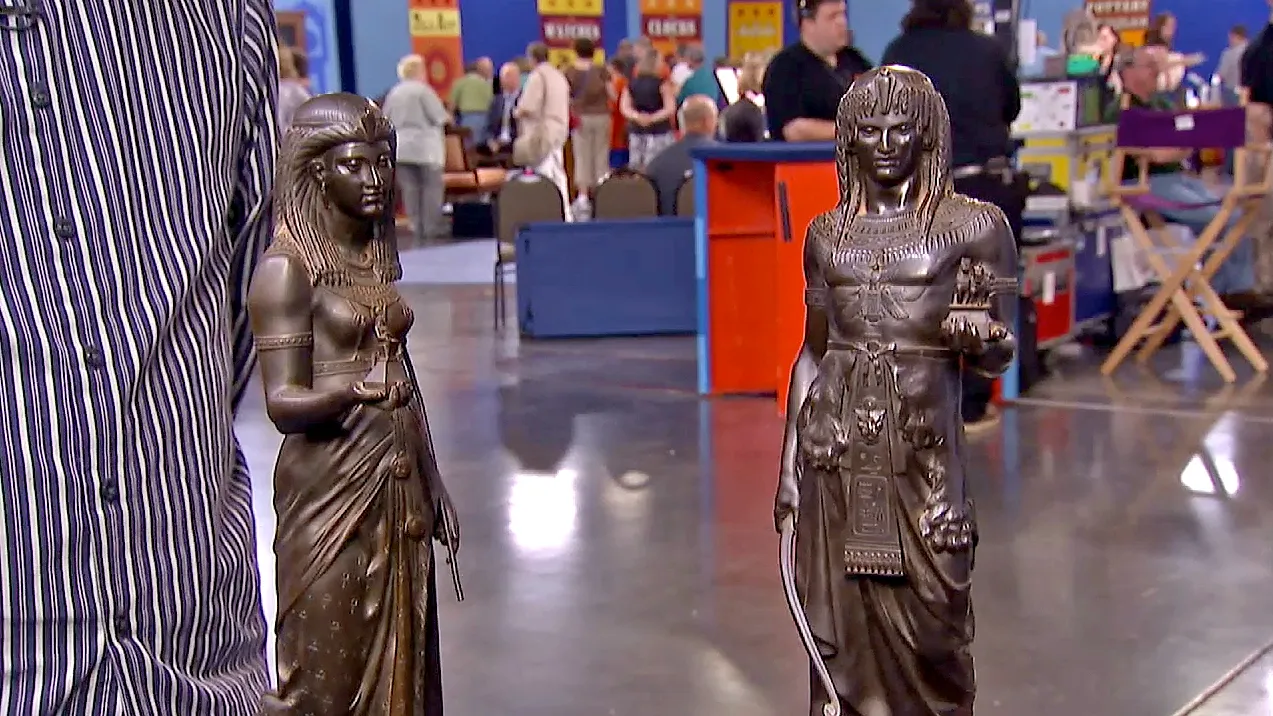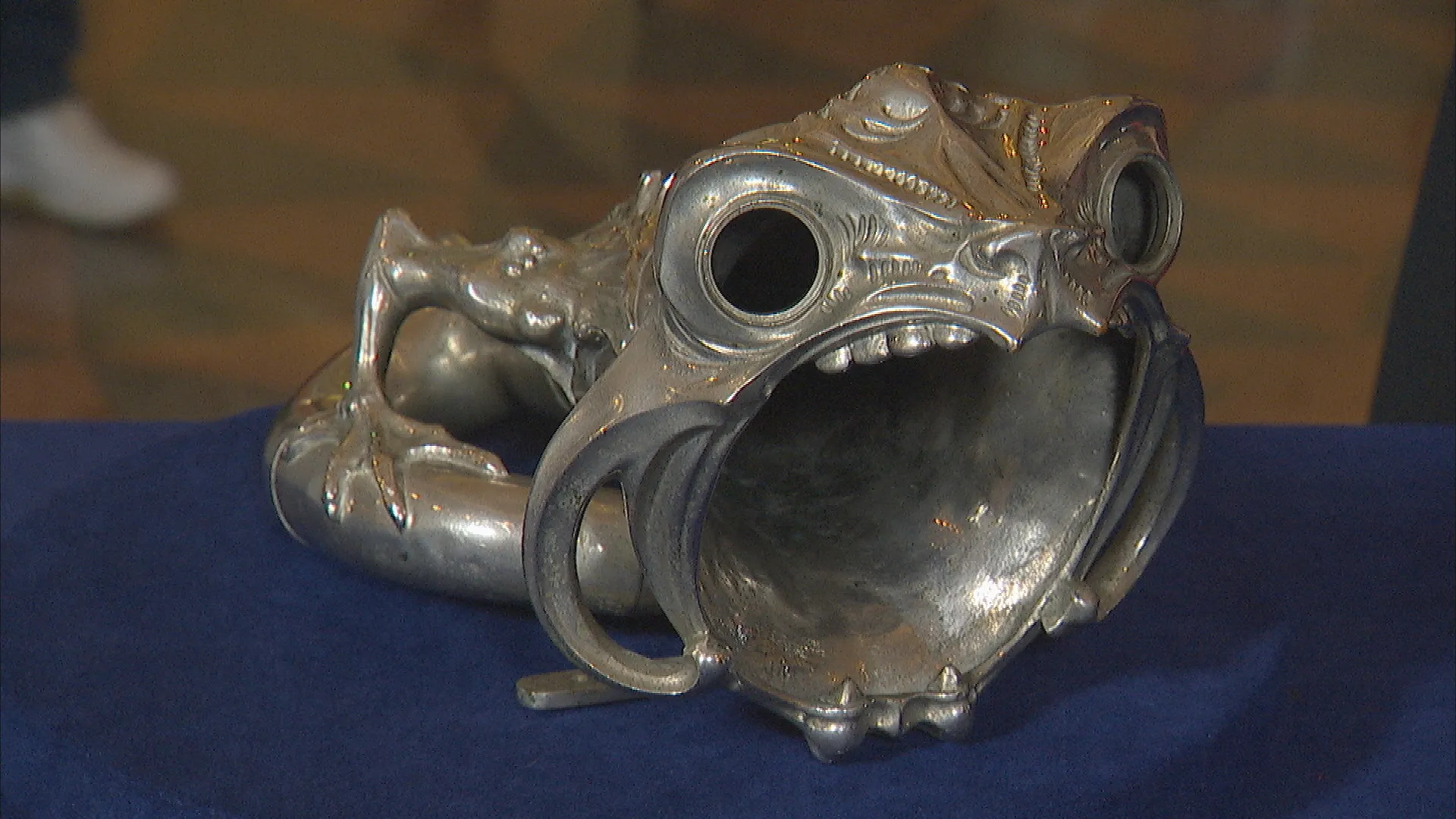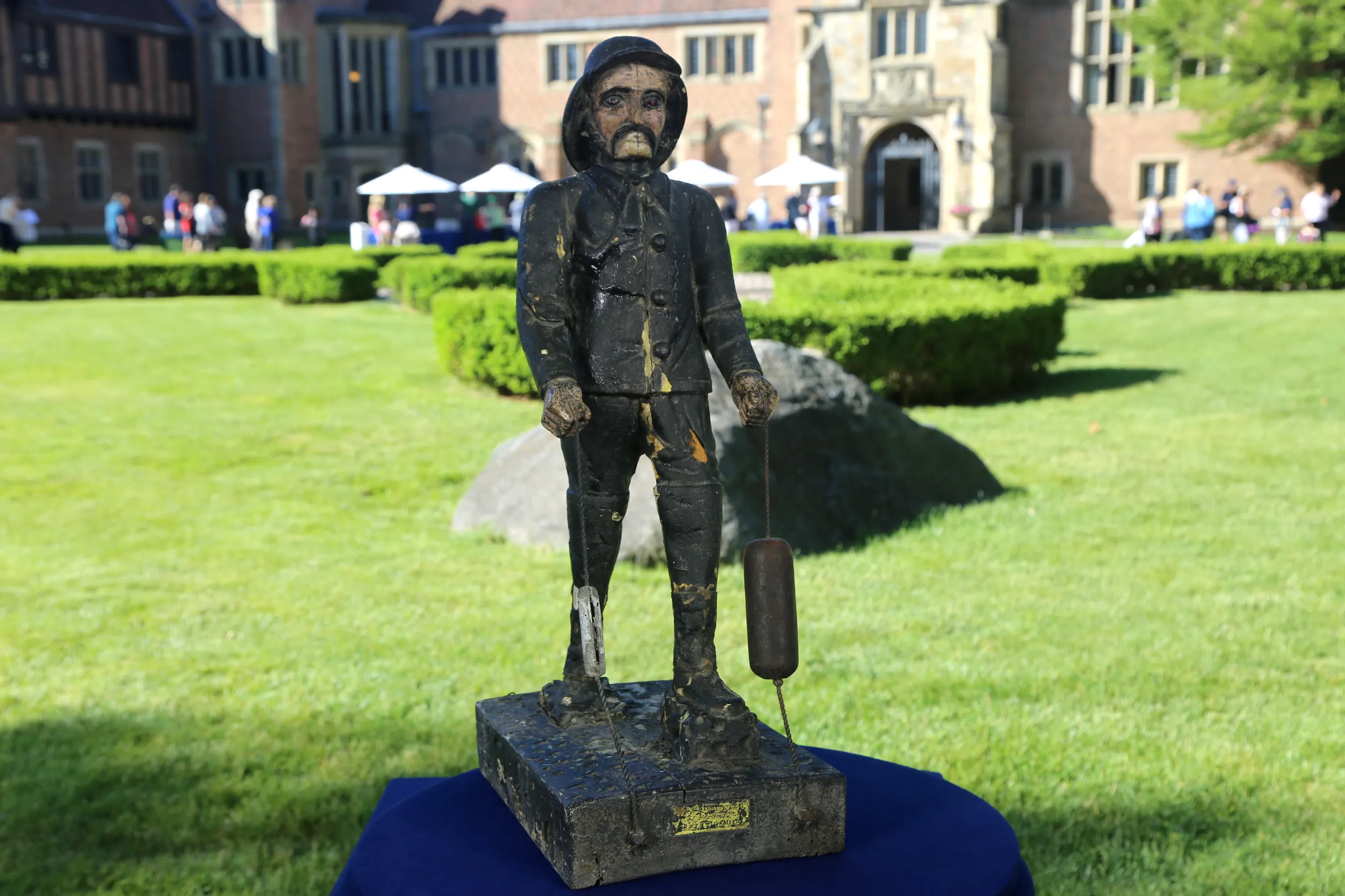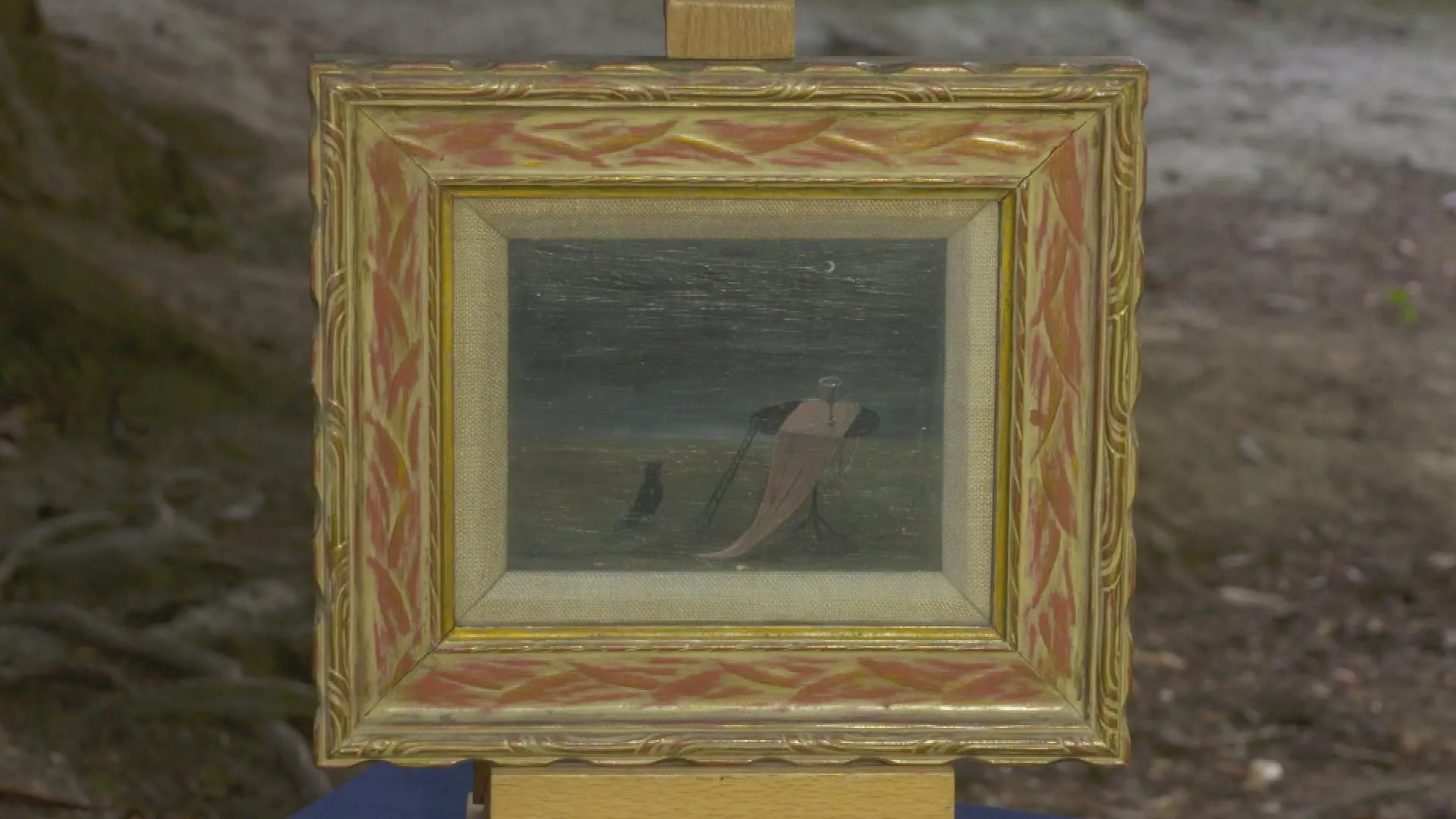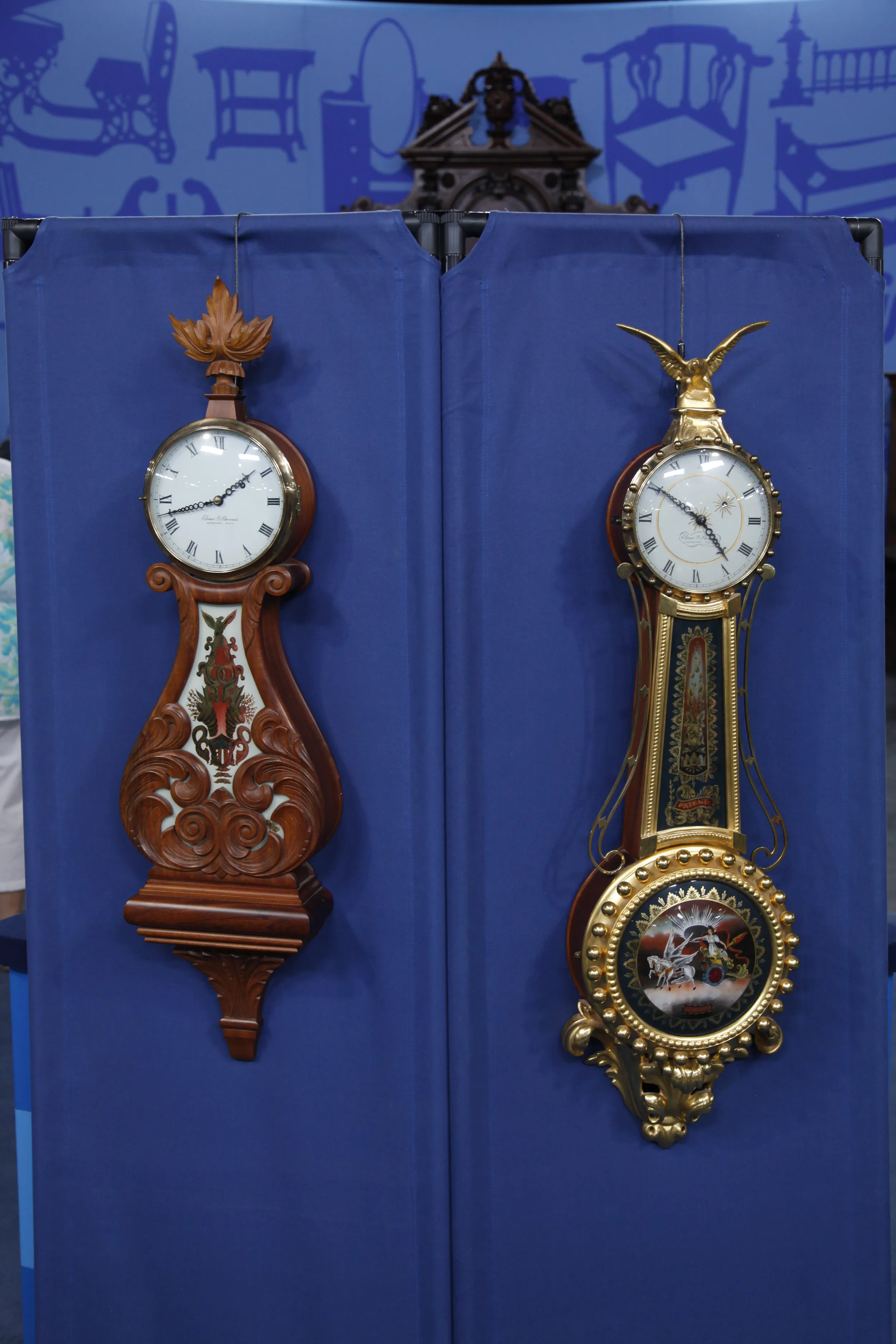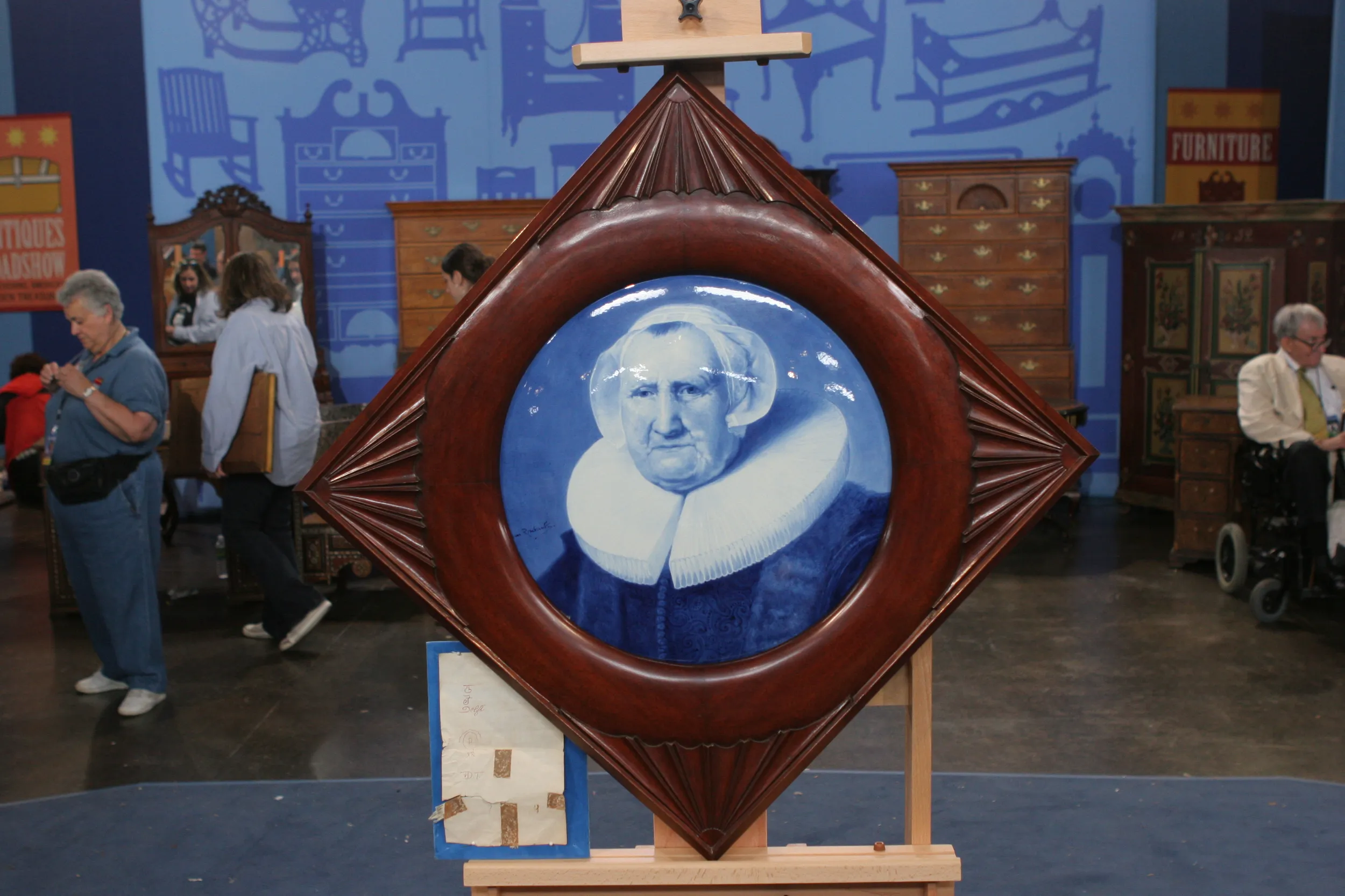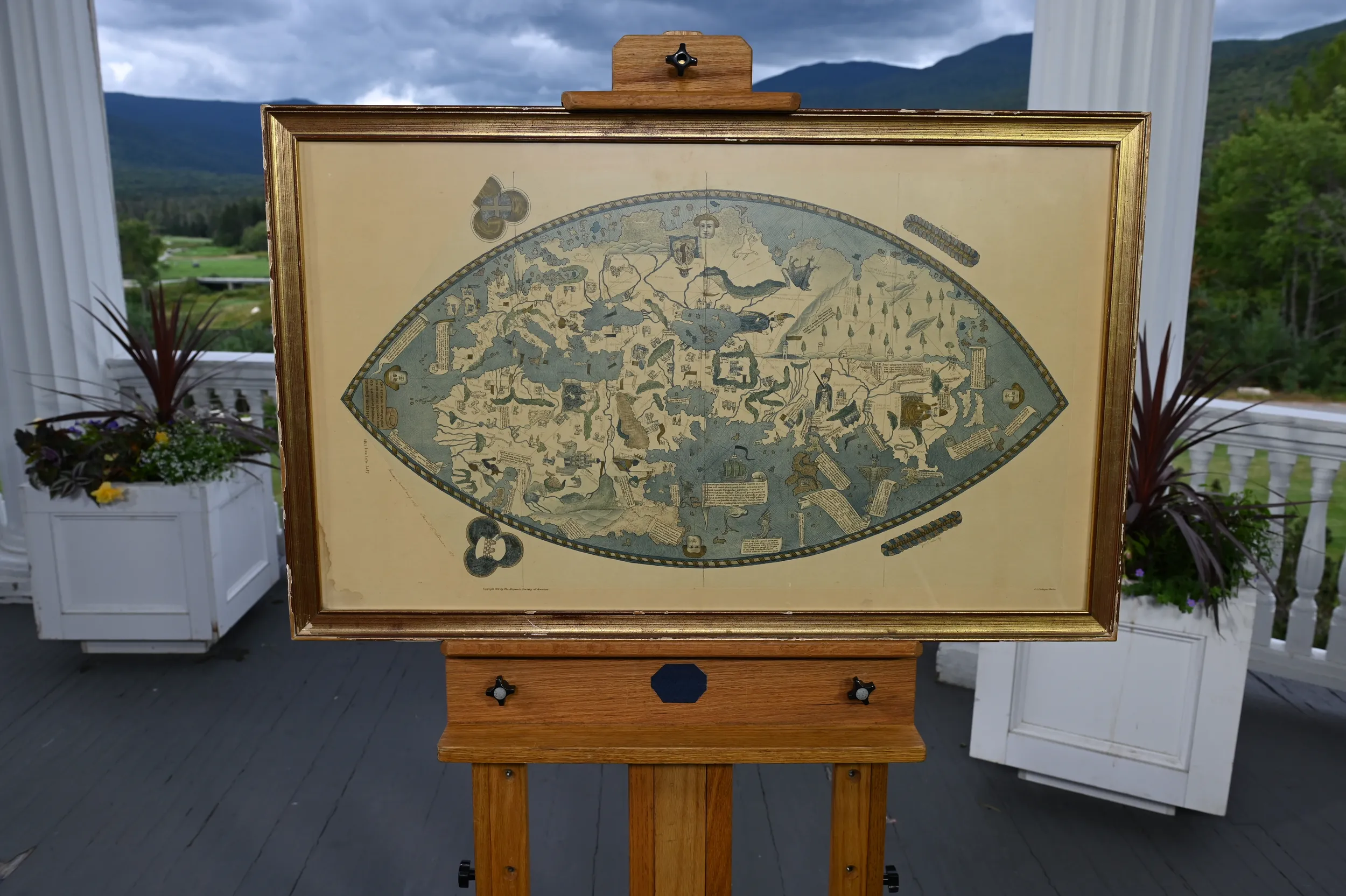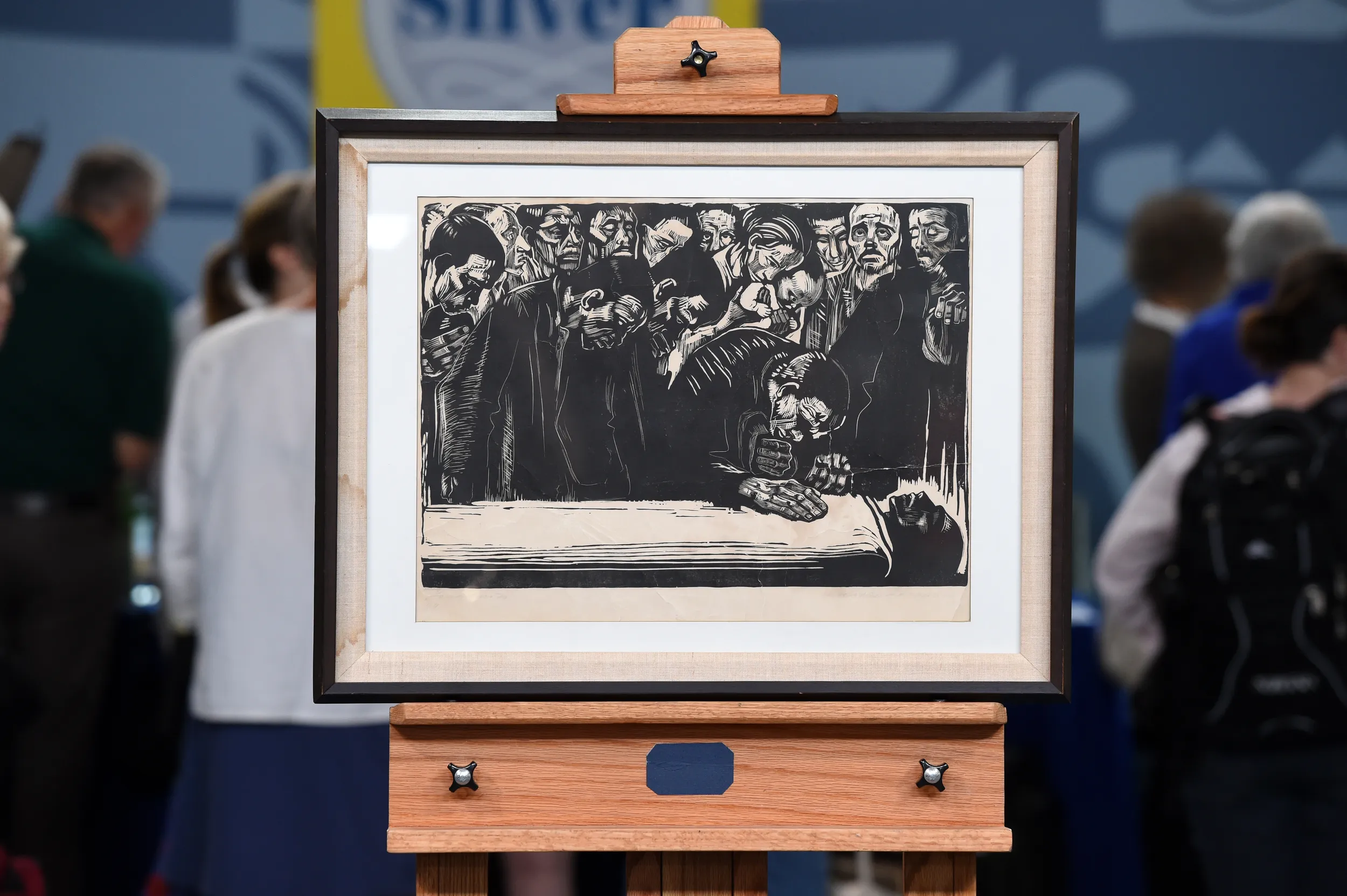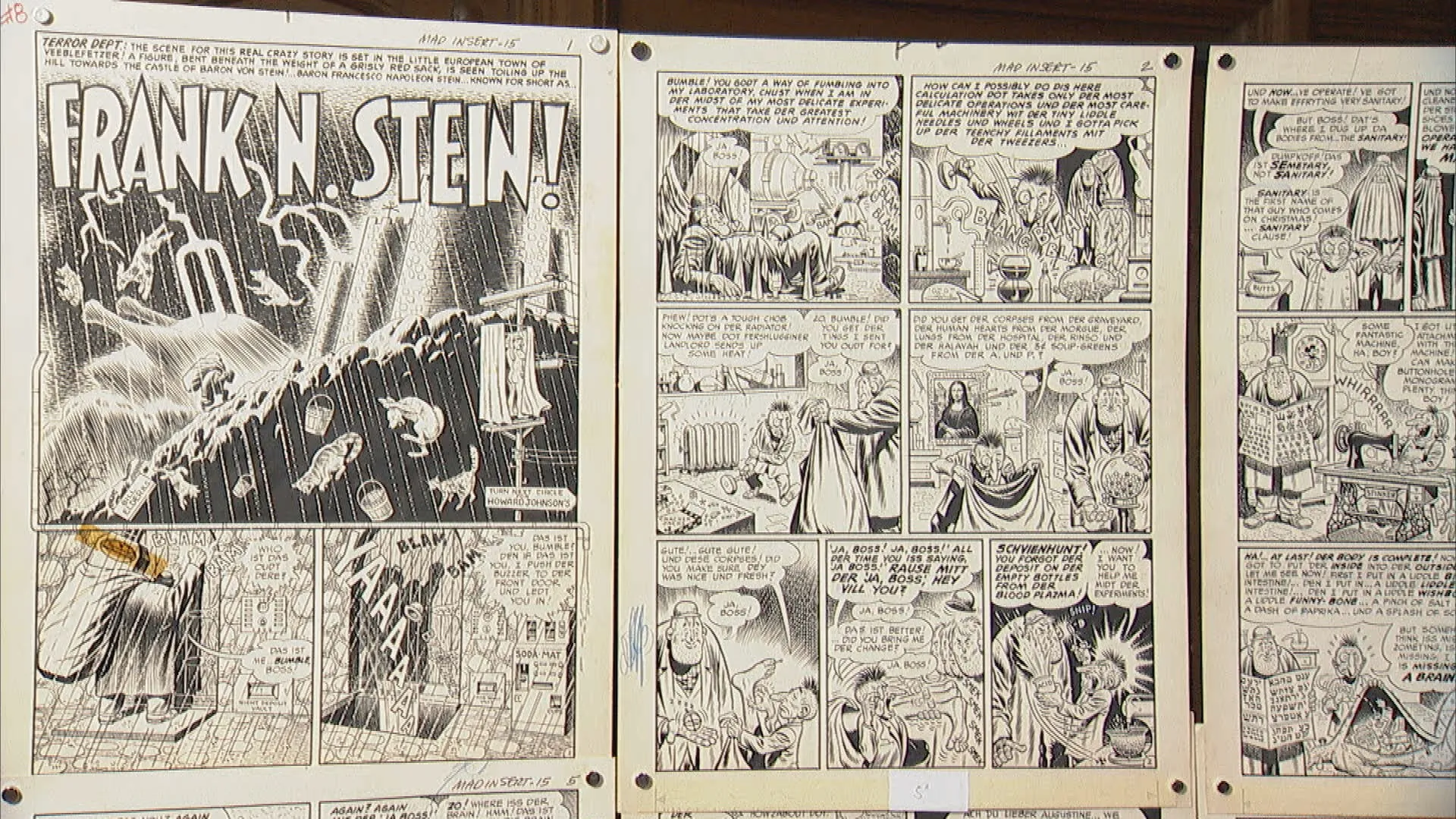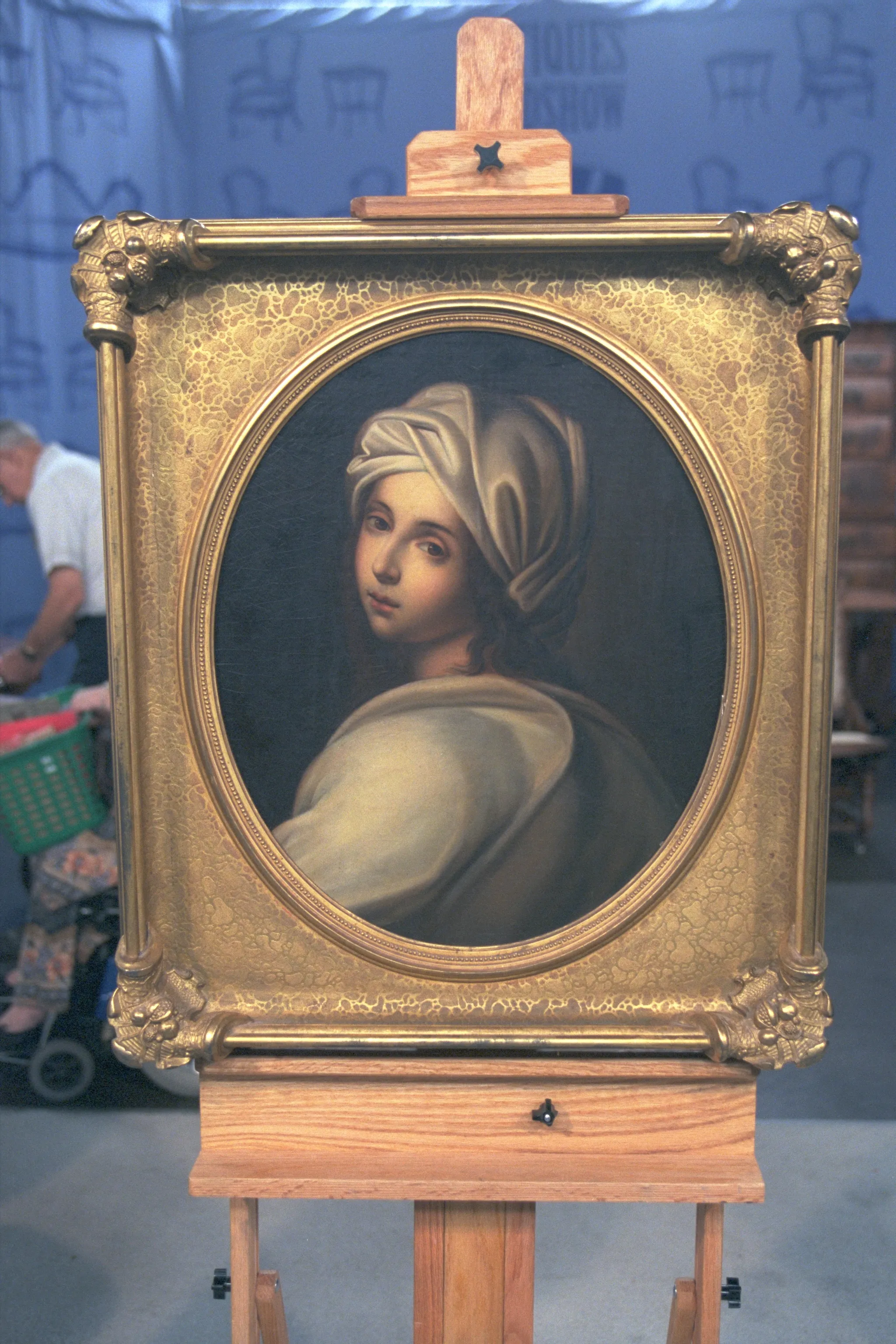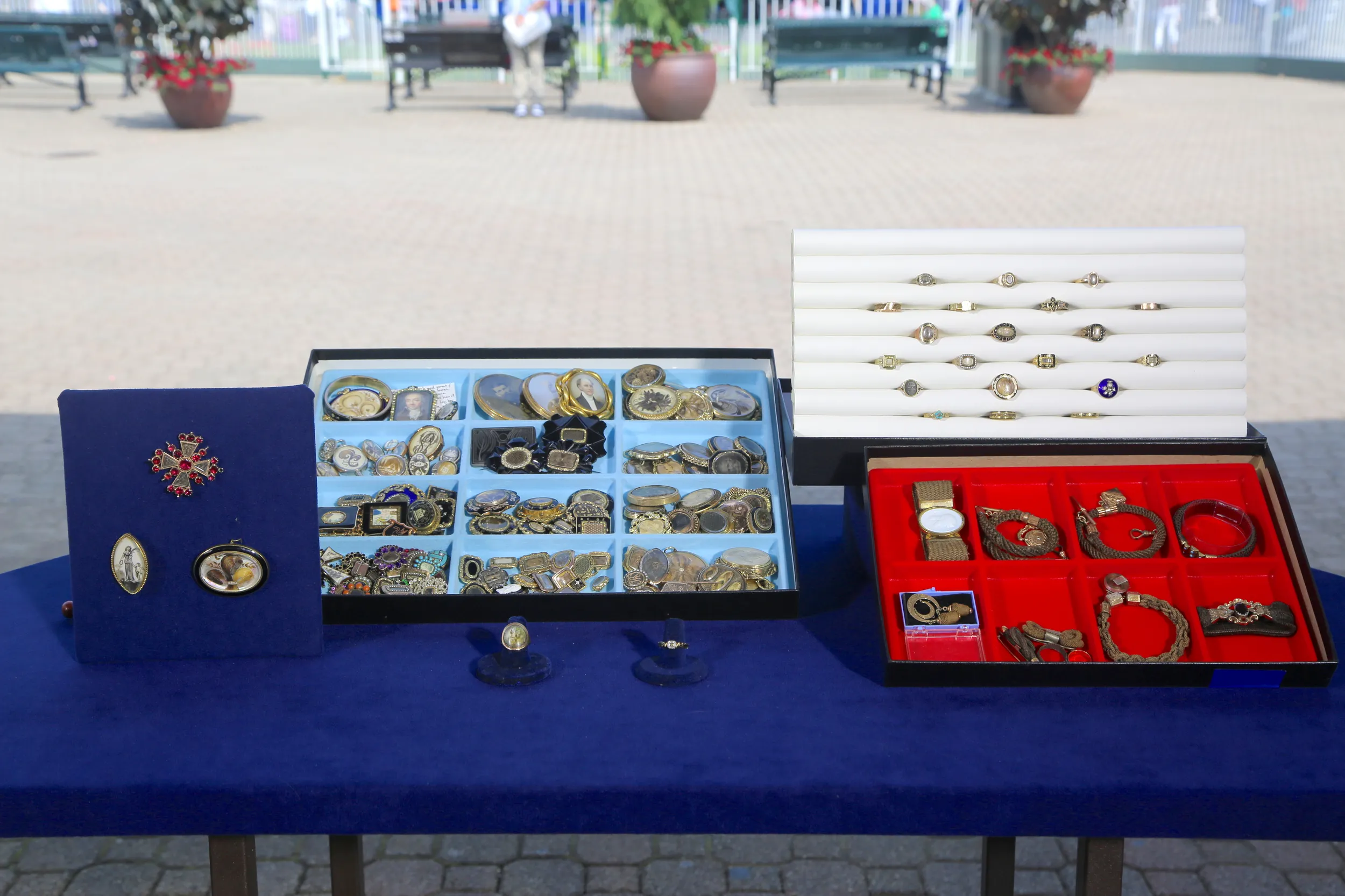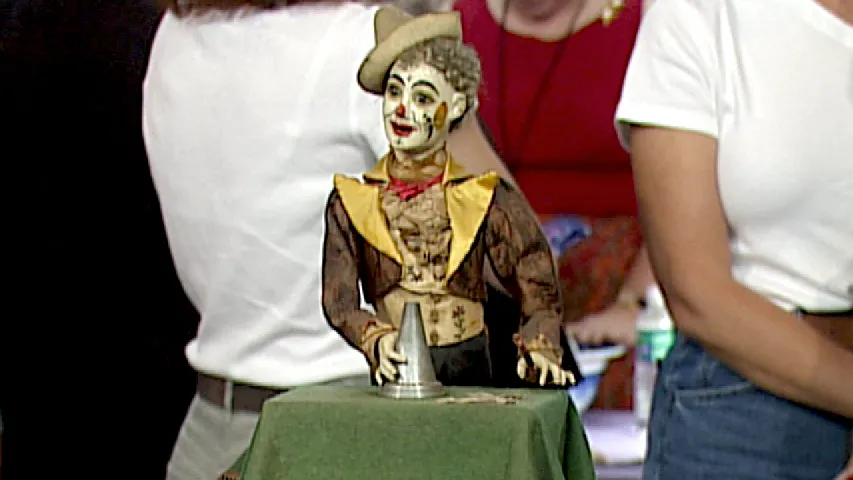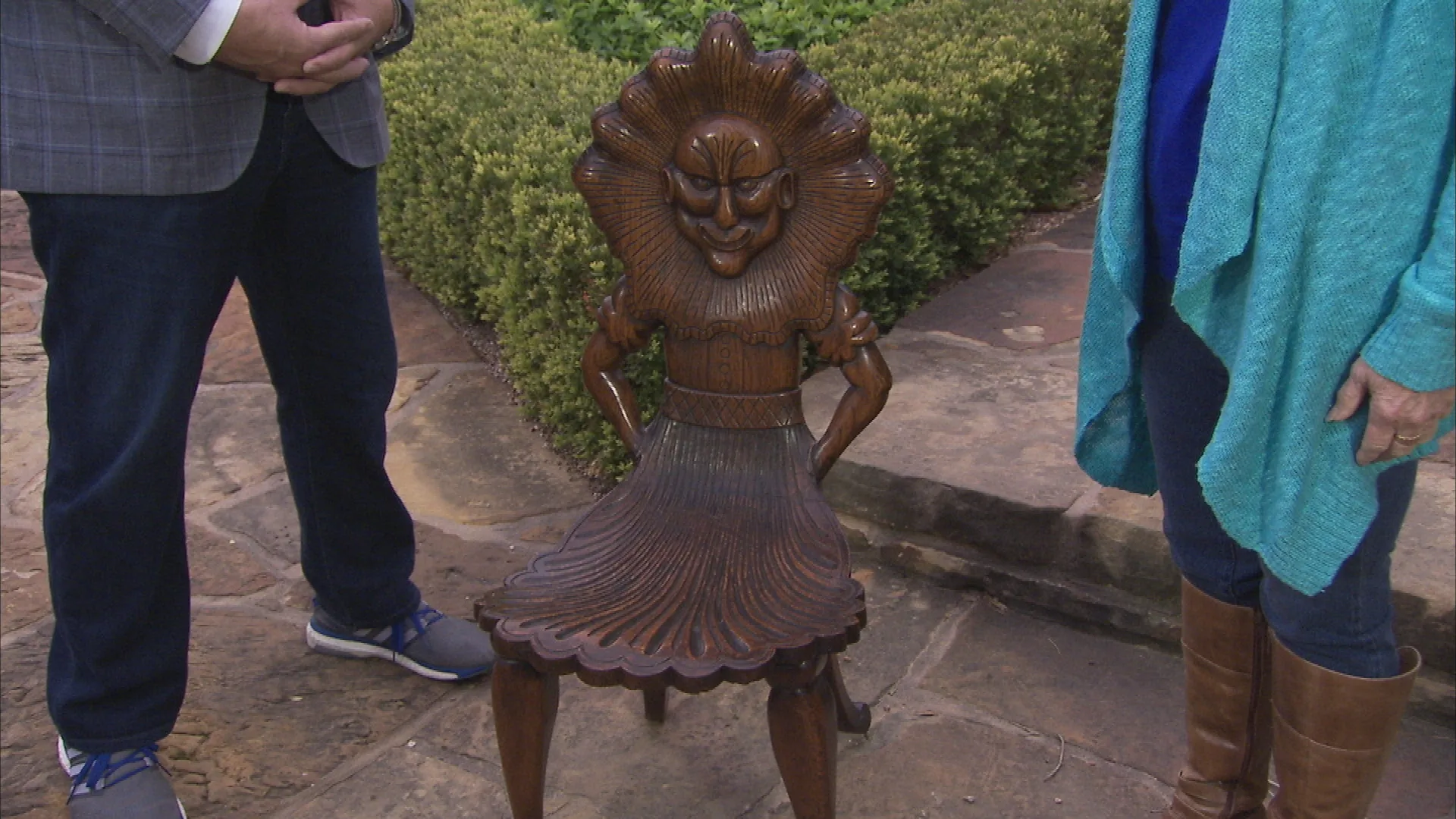HOST: Some treasures make you feel uneasy.
GUEST: We have decided as a family that he's probably haunted.
HOST: Some are scarily intriguing.
GUEST: Something drew me to him. I just think this stuff is fascinating.
HOST: Buckle up for a heart-racing hour of ANTIQUES ROADSHOW, Thrills and Chills.
HOST: Did you ever get the feeling that something was watching you?
GUEST: I used to walk up the stairs to the landing, then make a left up another set of stairs, and her eyes were always looking right at yah.
GUEST: I was terrified of this chair. I remember insisting that they either removed it from the room or that they covered it up.
HOST: Or have you been fascinated by an old conversation piece with a terrible past?
APPRAISER: She took revenge on his murder and invited all of the conspirators of the murder to a banquet, and once the banquet was underway, she had the entire banquet flooded, drowning everybody but herself.
HOST: The treasures in this special ROADSHOW episode may make the hair on your arms stand up, starting with a handsome but haunting portrait.
GUEST: Well, we believe this is Aaron Delano, and he would be my fifth great-grand-uncle. He's actually been hanging in my grandmother's house when I was young, and then went to my parents' house. And now I own him. And we believe, through both research and word of mouth, that he was the youngest sea captain in the New England area. He was born in 1767, and unfortunately, he passed away, lost at sea in 1794. But while he was alive, we believe he was doing a trade route on the New England coast from Plymouth to Nantucket, up the coast to Turner, Maine, and sometimes to Nova Scotia. Over the years, we have decided as a family that he's probably haunted. And, um...
APPRAISER: (laughs)
GUEST: When I was, um, a, a teenager in my home, when we got, when my parents got him, they'd hang him in the front stairway, and I would swear that I could hear him open and close the front door, walk up the stairs, and, and walk down the hall. And I would think it was my father or my mother coming home, and I'd go out, and there was no one there. And my older sister also experienced the, the walking sound in the hallway. When I was taking the, the picture down to, to bring it here, my husband was helping me, we're... He was on the ladder, and all of a sudden, the ladder slipped and went, "Oh!" And he's, first thing he said was, "Oh, Aaron." (laughs)
APPRAISER: We see portraits of people's relatives all the time, and very, very seldom do we ever see anything with this much going on in it. It's as much an, uh, an illustration of his occupation as anything else.
GUEST: Mm-hmm.
APPRAISER: But he's very handsome.
GUEST: Mm-hmm.
APPRAISER: He's young. I love his face and the way that's painted, and I love the patterned cloth on his vest.
GUEST: Mm-hmm.
APPRAISER: And there he's using the tools of his trade.
GUEST: Mm-hmm.
APPRAISER: That looks like a map. And that instrument is an octant.
GUEST: Oh.
APPRAISER: Which means that it would do an eighth of a circle.
GUEST: Okay.
APPRAISER: But they were used for navigational purposes. It's hard to see how good this is right now because it's behind this glass.
GUEST: Mm-hmm.
APPRAISER: Normally, you don't put oil paintings behind glass, 'cause this is an oil on canvas. And we know that it's 18th century, and we know that it's American. So you add all that up with what's illustrated in this, and I think you have something that's very extraordinary in terms of what appeals to people who collect Americana and folk art. We don't know who the artist is.
GUEST: Okay.
APPRAISER: 'Cause lots of times, these artists were itinerant.
GUEST: Mm-hmm.
APPRAISER: And we don't know who a lot of them were. Just in the condition that it's in right now, it's got paint loss.
GUEST: Mm-hmm.
APPRAISER: If you look right here, I think there's actually some film on the glass.
GUEST: Oh, okay.
APPRAISER: But, most importantly, there's no loss in his face or in the instruments and the detail of the painting that I think really makes it valuable. And so, after much conversation at the folk art table, we feel like at an auction, in as-is condition, its value would be $8,000 to $10,000.
GUEST: Okay, that's good, that's exciting.
GUEST: It belonged to my aunt...
APPRAISER: Yeah.
GUEST: ...who lived in Highland Park, Illinois, outside of Chicago. And this was in their study, and they used to have me sleep in that room, and I was terrified of this chair. I remember insisting that they either removed it from the room or that they covered it up.
APPRAISER: How old were you, about?
GUEST: I was about five or six.
APPRAISER: Okay, I understand that.
GUEST: And it just terrified me. They used to call it the man chair. And the only thing I heard about it, and it's more of a family myth than anything else...
APPRAISER: Yes.
GUEST: ...was that my grandfather, my mother's father, won it in a poker game in Chicago and that it came out of a bordello.
APPRAISER: Okay, okay.
GUEST: So that's the only thing. And whether or not that's true, I don't know.
APPRAISER: Well, this comes under the umbrella, this chair, of fantasy furniture. And fantasy furniture is really when a traditional furniture maker departs from the normal chairs that they're making, or furniture they're making, and creates something that's otherworldly, that's purely fantasy. And this man, this mask on the back, has roots centuries ago in history. We call it the Green Man.
GUEST: Uh huh.
APPRAISER: And this chair, which is late 19th century, actually is green-- that's the original green paint.
GUEST: Mm-hmm.
APPRAISER: This mask we see in Europe, on churches, on medieval castles. You'll see it as keystones. What it really represents and symbolizes, this, this Green Man has always symbolized rebirth, life, regeneration, and nature, and we usually see this mask on beds, on sofas, we'll see this mask, but never-- I've never seen the whole body of the Green Man.
GUEST: Mm-hmm.
APPRAISER: This has the knuckles. Look at these little cuffs.
GUEST: Mm-hmm! Mm-hmm.
APPRAISER: Incredible-- look at these hands, feel that. When you hold it...
GUEST: Mm-hmm, mm-hmm, mm-hmm.
APPRAISER: ...it sort of gives you the chills a little bit.
GUESET: Yes.
APPRAISER: It's actually very nice.
GUEST: Mm-hmm.
APPRAISER: But you can actually feel the fingernails like a real person.
GUEST: Mm-hmm, mm-hmm, mm-hmm.
APPRAISER: These branch-like, twisting, almost like they're growing vines, supporting the legs.
GUEST: Mm-hmm.
APPRAISER: Very Art Nouveau in influence. Now, the great thing about this, if we can turn this over, if you can help me, look on the, on the bottom, there's this little label here.
GUEST: Mm-hmm.
APPRAISER: And it says "The Harry J. Dean Company Special Furniture." And then Detroit, so we know it was made in America. So made in about 1890. The great thing is, look at that original paint, all the green.
GUEST: Mm-hmm, mm-hmm.
APPRAISER: And look at these feet.
GUEST: What kind of wood is it?
APPRAISER: That's actually mahogany.
GUEST: Mm-hmm.
APPRAISER: I'd put a value on this at pr, probably, for fair market value purposes, right in the range of $3,000.
GUEST: Okay.
GUEST: My doll has been in the family for at least 50 years. And before that, I'm not sure where exactly she was. I was told that she was a French fashion doll. My parents were antiquers. On Sundays, they would go to different antique shops in Massachusetts, and because I was the youngest, I got to go, too. Not very long into that, I hated it. One Sunday-- I used to stand in the corner while my parents would look at all the furniture-- there was this doll, and my mother said, "Do you like it?" And I said, "Oh, yeah, I really like it." So they bought it, took it home. It was my doll, but I wasn't allowed to play with it.
APPRAISER: (chuckles)
GUEST: It was put behind glass and I could look at it. We knew that she was probably worth a lot of money, since it's the original outfit. So we took it to this doll hospital, and that was kind of creepy. The man that came to the door was very interesting-looking. And we walked in, and the dolls were all in pieces, and they were all staring at you because they're all hanging on the walls. And it was very dark-- it was just not pleasant. And then there was another man there who had a very long beard, and he looked at the doll and he said, "Can we keep her to evaluate her?"
APPRAISER: Mm-hmm.
GUEST: Week later, they called us and said, "You've got to come down, you got to come down! This is the highest-priced doll we've ever saw!" "Really?" So we went down, and they said, "She's worth $16,000." And we went, "Okay." And just kind a... So then, a few years later, we went to this wannabe ROADSHOW-- it was not the ANTIQUES ROADSHOW-- and we had her evaluated again, and they told me it was worth $3,000. My hus... And they wanted to purchase her. And my husband said, "Oh, no, she's worth $16,000."
APPRAISER: (chuckles)
GUEST: And again, it was, like, "Really?"
APPRAISER: It's very inappropriate and unethical...
GUEST: Really?
APPRAISER: ...in our business to offer to buy something after we appraised it. This is a little doll made by Schmitt and Fils of Paris, France, so she is a French doll. She's not a French fashion doll, as you describe, but she's actually a French bébé. She's in her original French costume with her little straw hat, her little lace dress, her wonderful socks, and her original labeled shoes. She's made of bisque, and she has paperweight eyes and a composition body. When we turn her around, we will see that she is marked. And it's very difficult to see under her little wig, but there's a little shield mark that stands for Schmitt.
GUEST: Okay.
APPRAISER: And then we have "000."
GUEST: I saw that.
APPRAISER: And then also on her bottom, we would see that it's marked the same way. She has pierced ears with her most likely original turquoise earrings. These dolls were made in the 1880s, and they were sold as the finest French dolls.
GUEST: Oh, fabulous.
APPRAISER: Beautifully made. Very excited to see her. So now we need to decide if the fake appraisal fair or the weird man with the long beard is right about her value.
GUEST: (laughs): Okay.
APPRAISER: A little doll like this, at retail, would sell for $16,000 to $18,000.
GUEST: Oh, my goodness.
APPRAISER: I've even seen ‘em at auction sell for more.
GUEST: Wow.
APPRAISER: Very desirable, high-end doll.
GUEST: Well, I guess I shouldn't have laughed. (chuckles)
GUEST: I have two bronze statues that have been in my family for quite a while, and I've always admired them since I was a little boy.
APPRAISER: They are bronze castings by Émile Picault, who was a French artist. They were a model that he first did in 1867, and these were probably done shortly thereafter, circa 1870.
GUEST: Mm-hmm.
APPRAISER: He did them in a couple of different sizes. Uh, there is one size larger than this, and they depict an Egyptian king and queen, King Menthuophis and Queen Nitocris. They were both husband and wife and brother and sister.
GUEST: Oh.
APPRAISER: But, uh, he was actually murdered. And she took revenge on his murder and invited all of the conspirators of the murder to a banquet, where she had constructed a special room. And once the banquet was underway, she had the entire banquet flooded, drowning everybody but herself.
GUEST: Wow.
APPRAISER: But, however, she committed suicide shortly thereafter. These do have some condition issues. Primarily, the patina on the base should be very gold.
GUEST: Mm-hmm.
APPRAISER: And it's quite worn. In this condition, probably, uh, at auction, you would expect them to bring between $12,000 and $18,000 for the pair. In perfect condition, or a little bit better condition, probably as much as $25,000 or $30,000.
GUEST: Wow, that's great.
APPRAISER: Okay, you brought in this beautiful serpentine piece. It's Victorian.
GUEST: Okay.
APPRAISER: It's really delightful, it's a pretty form. You asked me about the back.
GUEST: Right.
APPRAISER: I don't want to creep you out.
GUEST: Okay. (chuckles)
APPRAISER: It's hair.
GUEST: Okay.
APPRAISER: Okay? It's a mourning piece. They still wanted a little remembrance of somebody, so they snuck it in the back of the snake's head.
GUEST: Okay. I purchased it at a thrift shop for $20.
APPRAISER: Unbelievable-- 'cause you could add a couple of zeros to that $20. Yup. (laughs)
GUEST: They thought the piece originally was from Transylvania.
APPRAISER: It's actually probably from Vienna.
GUEST: Okay.
APPRAISER: And it'd be wonderful to think that it was, given the bats that we have on it.
GUEST: (chuckles): Sure, sure.
GUEST: This is an antique car horn that was given to my great-uncle by a customer who really appreciated his service while he was the service manager at the Cadillac dealership in Memphis, Tennessee. They used it as a doorstop. Originally, it had green glass eyes in it. And my aunt thought that it was really creepy, and it was watching her all the time, so she popped the eyes out.
APPRAISER: Oh, my goodness.
GUEST: And we don't know where they are.
APPRAISER: It's truly one of the most spectacular things I've seen at ROADSHOW. It is a circa 1915 Art Nouveau silver-plated car horn in the form of a grotesque or a gargoyle. And as you can see, it has wings, it has claws. The horn looks like it was actually made by a music maker who would have known exactly how to bend the metal. The workmanship here is just so spectacular. The claws-- I can see why it might have creeped your aunt out, but...
GUEST: (chuckles)
APPRAISER: Uh, it's just, it's so wonderful. You've got this bar here where it would have been attached, and here you would have had the horn, so you could have just reached out the window to make it sound. It's French, probably made in Paris, because Paris had the great metal foundries in the 19th and early 20th centuries. The French love monsters. And in the late 19th century, which is right around the time things like this started getting made, the French had what they called the Grand Guignol theater, which was the theater of horror. And the themes were death, monsters, terror, and the French loved it. Unfortunately, the eyes are missing. But even so, I would estimate it on today's market at between $1,500 and $3,000.
GUEST: Okay.
APPRAISER: If it still had the eyes, you're looking at $2,000 to $4,000.
GUEST: Okay.
GUEST: And the fisherman came from my great-grandfather's house. Um, he bought the home from a man that owned a fleet of fishing boats, and it was carved for him.
GUEST: This fisherman was found in a home that my great-grandfather purchased. And the owner of the home previous to him was a captain of a fishing fleet. And it came from Alpena, Michigan. After my great-grandfather owned it, it came down to my mother, and as a child, he lived in our basement. And with those terrifying red eyes in the black corner next to the coal bin, we were afraid to go to the basement. (chuckles)
APPRAISER: What we have here is a late-19th-century trade sign.
GUEST: Trade sign?
APPRAISER: It's, it is a sign that is beckoning a profession-- a fisherman-- where one would go in and buy fishing supplies for the profession.
GUEST: Oh.
APPRAISER: So the fact that it was owned by a professional fishboat captain makes a lot of sense. And a piece like this is carved wood, and the wood is white pine.
GUEST: Mm-hmm.
APPRAISER: And it was a, a wood that was very, very favored by the trade shops because it was soft, it was easy to carve, and it took paint very nicely. And this would have been carved out of a two-foot log. And what is wonderful about the piece is, it's virtually untouched and it's wearing its historic surface. And we have a very important thing going on here, and that is the beautiful 19th-century nameplate that was put on when the piece was made that says "T," which is for Theodore, and "Crongeyer," a street address in Detroit, Michigan.
GUEST: Uh-huh.
APPRAISER: And we know his shop, he did church work, he did tobacco store trade figures, he did design work. So this figure would have been outside a shop, possibly up high, over the door of the shop, so that people, when walking down the street in either direction, could see what is going on inside that shop. Don't forget, it's 1875-- people coming to America, many of them can't read, can't speak English.
GUEST: Okay.
APPRAISER: So this becomes a sign language.
GUEST: How wonderful.
APPRAISER: When we turn it around and we take a look, we see etched into the side of the piece the word "fisherman."
GUEST: Mm-hmm.
APPRAISER: That was done at a later date. And when we go around to the back, We see a wonderful surface. And you said that this was stored near the coal bin.
GUEST: Correct.
APPRAISER: I suspect it was subjected possibly to heat.
GUEST: Oh.
APPRAISER: And that's how you created the surface over here. I think today it's a desirable piece for the folk art collectors that collect trade signs. But, really, these are so rare because the number of shops that sold s, fishing supplies were quite few. The number of tobacco shops were, were plentiful. Many more. So we're going to put a retail valuation today of $3,000 to $5,000.
GUEST: I'm amazed. (chuckles)
APPRAISER: Yeah, I think it's, it's...
GUEST: Wow.
APPRAISER: ...being a little conservative, too. I think it's a very desirable form by a, a known maker, who's quite rare, actually. It's a wonderful piece.
GUEST: Wow, thank you, Mr. Katz, I'm so surprised. Thank you for telling us it's a sign. Who would have guessed? Well, you knew. (both chuckling)
GUEST: When I was a little kid, my parents got it at a yard sale in Chicago. They were looking for a salt shaker for their brand-new house, but they saw this there for five dollars, and they just had to get it. And ever since then, it's just been on the wall in our house, and I've just always been curious about it.
APPRAISER: Do you know when your parents bought it?
GUEST: Well, I was about one at the time, so I think, like, '98, '99.
APPRAISER: Well, the painting is by an artist named, uh, Gertrude Abercrombie. It's signed and dated, 1945, oil on panel.
GUEST: Okay.
APPRAISER: She is known as a bit of a bohemian artist, a Surrealist, and she worked in Chicago.
GUEST: Okay.
APPRAISER: So it makes sense that you would find it there. She also has a lot of s, associations with jazz. Dizzy Gillespie actually played at her second wedding.
GUEST: Oh, wow.
APPRAISER: She's known for these Surrealist paintings. She considered them somewhat of a self-portrait. And we know that, she said that-- I'm not making it up. (both chuckling) In this particular painting, we can see the owl. There's the moon...
GUEST: Mm-hmm.
APPRAISER: ...and the cloud, the cup on the table there. The proverbial witch's brew.
GUEST: Mm-hmm.
APPRAISER: She had trouble with alcohol, as well, so I, I think we see aspects of her vision of herself as kind of a, a witch, a character outside of, uh, the normal.
GUEST: That's really interesting.
APPRAISER: And it's all in a very barren place. I think at auction, even though it's only four by five inches, uh, we would give it an estimate of $8,000 to $12,000.
GUEST: Wow, wow, that, that's a lot.
APPRAISER: More than five.
GUEST: That's... (chuckles) I would, I would have guessed, like, maybe $35.
APPRAISER: Yeah.
GUEST: Wow.
APPRAISER: Her work is quite rare and it's also on a major upswing. Her strongest prices are all within the last five years.
GUEST: Wow.
GUEST: So I brought a portion of my John Wesley Hardin collection, a cattle brand ledger from before he went on his long stint in Huntsville prison. After he got out of prison, he became, uh, an attorney, moved to El Paso. So I brought his El Paso business card, his, uh, autobiography that was published after his death, a playing card that he would shoot. I don't know if it was to get money or just to publicize himself. And then the death card that was taken after he was shot and killed in, uh, El Paso.
APPRAISER: John Wesley Hardin.
GUEST: Yes.
APPRAISER: (dramatically): "A man so mean, he once shot a man for snoring."
GUEST: Allegedly, yes.
APPRAISER: Yes.
GUEST: Yes.
APPRAISER: Why him?
GUEST: Having been in law enforcement, I think the Old West law enforcement and outlaw faction kind of interested me. And something-- he's intriguing. Something drew me to him. I just think this stuff is just fascinating.
APPRAISER: And how long did it take you to put this collection together?
GUEST: Uh, years, years.
APPRAISER: Years, yeah.
GUEST: Uh, and this is just, uh, a portion of my collection. And I thought it was the, some of the neatest stuff that really represented him.
APPRAISER: John Wesley Hardin is one of the most notorious outlaws of the Old West. He was a famous cattle rustler, and card player, or card cheat.
GUEST: Right.
APPRAISER: Also worked a little bit as an attorney. Spent some time in prison.
GUEST: Exactly.
APPRAISER: And then met an untimely death.
GUEST: Yes.
APPRAISER: Not surprisingly.
GUEST: Right.
APPRAISER: He was murdered in 1895. So we think of him as a cattle rustler, I think.
GUEST: Yes.
APPRAISER: Maybe first and foremost.
GUEST: Yup.
APPRAISER: So you brought this brand sheet.
GUEST: Right.
APPRAISER: Which records the individual cattle brand and then the owner that's associated with each brand. And John Wesley Hardin has signed twice here, here, and then again at the bottom. This small piece that you mentioned is his business card.
GUEST: Right.
APPRAISER: "Attorney at law"-- maybe the least famous part of his career.
GUEST: Yeah, right, very short-lived.
APPRAISER: And then maybe most famously as a gambler...
GUEST: Yes.
APPRAISER: ...and a bit of a showman and a bit of a self-promoter.
GUEST: Yes, definitely.
APPRAISER: The playing card is signed, dated, and has three shots in it-- really terrific piece.
GUEST: Right.
APPRAISER: And of course, the death card, too. No gunslinger reputation is complete without the morbid death card.
GUEST: Right, exactly, yes.
APPRAISER: Obviously, not signed. (chuckling): That's a facsimile signature with it.
GUEST: Yes.
APPRAISER: But we have the death card and the autobiography, which is really very much the source of his reputation.
GUEST: Exactly.
APPRAISER: Much of his self-generated publicity.
GUEST: Yes.
APPRAISER: Which is the way to do it, right?
GUEST: Yeah, absolutely.
APPRAISER: Can you tell me what you paid for the autobiography?
GUEST: I have five or six of them, all in different conditions. I think for this one, I probably paid maybe $200, 2, $225.
APPRAISER: How about the photograph?
GUEST: That I don't recall, I bought that so many years ago. I found it online and I just don't recall what I paid for it. Business card, I think I paid $444 for it.
APPRAISER: How about the branding sheet?
GUEST: I really, I don't remember that; the, uh, I remember the card.
APPRAISER: And what'd you pay for the card?
GUEST: The card, I paid a little over $2,000.
APPRAISER: Gunslingers are a popular collecting area.
GUEST: Right.
APPRAISER: Texas is a co...
GUEST: Yes, exactly.
APPRAISER: There are certain regions in America that appeal to collectors beyond their borders.
GUEST: Right.
APPRAISER: So that just the mythology of the area...
GUEST: Right.
APPRAISER: ...speaks to more than just the people who, who live there.
GUEST: Interesting, okay.
APPRAISER: And there are a lot of good recent auction records for him, so he's very hot.
GUEST: Okay.
APPRAISER: The autobiography is fairly rare. Supposedly, it was pulled from distribution.
GUEST: Exactly.
APPRAISER: But it's not a particularly expensive book. It, it, but you have a very nice copy. At auction, we would say, $500 to $700.
GUEST: Oh, wow, okay.
APPRAISER: The death card, also on the rare side.
GUEST: Right.
APPRAISER: Yours, it's a bright image, but it's got some condition problems.
GUEST: Right.
APPRAISER: It's been shellacked...
GUEST: Yeah.
APPRAISER: ...and the margins have been trimmed.
GUEST: Right.
APPRAISER: So I would probably put this in the $700 to $900 range.
GUEST: Oh, okay.
APPRAISER: The business card, several examples of this have sold recently.
GUEST: Right. Yeah.
APPRAISER: They're in the $2,000 to $3,000 market. Uh, between the two of these, which do you think is most expensive?
GUEST: I think the card, I just... I, I think they're very rare and really hard to come by. But then again, this is signed twice, so it's, it's hard to say.
APPRAISER: But, you're right, the card is more.
GUEST: Okay, okay.
APPRAISER: The card is sexier, right?
GUEST: Okay.
APPRAISER: It's sexier, more fun.
GUEST: Right, right.
APPRAISER: So the value of the signed brand would be between $4,000 and $6,000 at auction.
GUEST: Wow, okay.
APPRAISER: But, yeah, this is your star piece.
GUEST: Right.
APPRAISER: It's so compelling and magnetic. If you average out the, the last three auction records, it's probably $15,000 to $20,000.
GUEST: Wow, okay, a lot more than I thought.
APPRAISER: Yeah.
GUEST: That's, that makes me happy, it's, uh, very, like you said, very intimate. He shot that card, he touched that card, he signed that card.
APPRAISER: He signed-- exactly.
GUEST: Right. I'm, I'm very, very happy, that's, uh... I just love this stuff.
GUEST: We have my grandmother's bat necklace.
APPRAISER: What we have here is a real French Art Nouveau jewel. The material on the bat's wing is plique-à-jour enamel. And if we illuminate it from behind, you can see that it's fairly translucent. A fair auction estimate for this piece is in the range of $4,000 to $6,000.
GUEST: (laughing): Really? I'm shocked. (laughs) Thank you, Grandma!
APPRAISER: You got it from a friend.
GUEST: Yes.
APPRAISER: He worked for the studios?
GUEST: Yes, but it says "Universal" on his foot.
APPRAISER: It sure does. Certainly could have been made for Universal. The key is if we can find out if it was in a movie. Without knowing the movie, just a generic, crazy monster with "Universal" on it...
GUEST: (laughs)
APPRAISER: ...I think it's maybe $200, $300.
GUEST: Really?
APPRAISER: If you could figure out the movie, if it's a movie that people know, we could double, triple up on that.
GUEST: I found it in a little antique store outside of Boston about 15 years ago.
APPRAISER: Okay, and do you know who it is of?
GUEST: Oh, yes. I knew exactly who it was when I saw it: Lizzie Borden.
APPRAISER: Oh, okay, and what did you pay for it?
GUEST: One dollar.
APPRAISER: This is a, uh, good photograph of Lizzie Borden. Her trial in 1893 for murdering her mom and dad with an axe within 90 minutes of each other was one of the most sensational trials in American history. Now, she was acquitted after a two-week trial in a matter of moments by, uh, a all-male jury, then stayed in Fall River, Massachusetts, and was always perceived to be the guilty person for the rest of her life. And there was a tune, you know.
GUEST: Oh, sure.
APPRAISER: Lizzie Borden took an axe, and hit her mother 40 whacks-- something to that effect. You have spoken with the Fall River, uh, Historical Society.
GUEST: Correct.
APPRAISER: They said that they bought all the negatives for this photographer.
GUEST: Right.
APPRAISER: And did they have this image?
GUEST: They didn't have the actual copy themselves.
APPRAISER: Okay.
GUEST: They just had the negative so they could make the print.
APPRAISER: Okay, so they also thought that this photograph was pretty rare.
GUEST: Right.
APPRAISER: Okay, so then you have a historical figure of kind of real interest, and then rarity. So that comes together-- now, you paid a dollar for it.
GUEST: Right.
APPRAISER: I would think the real value would be $600 to $900.
GUEST: Great!
GUEST: So I brought two clocks. They belonged to my late father-in-law, who loved clocks. He was a jeweler and a watchmaker. And I particularly liked these. I thought they were very pretty clocks. They were made by the same man. I don't know a whole lot about him. I understand he's from Massachusetts. They're signed "Massachusetts," so...
APPRAISER: The person that made these clocks is one of the more interesting reproduction clockmakers. In the 1960s, he started making clocks of this type here called a girandole clock, which is considered one of America's most beautiful forms, having the gilt case, the convex glass, really nicely decorated. And then also this clock here, which is a design probably by John Sawin, a Boston clockmaker, which is called a lyre clock or a harp clock. Both of these clocks were probably made in the '70s sometime, 1970s. But the forms come 1825, where they were first popular. What makes these clocks particularly collectible is the fact that they were made by Elmer Stennes. He was a really skilled woodworker and who was a very interesting person. Elmer Stennes has the dubious distinction of murdering his first wife.
GUEST: Oh, my.
APPRAISER: In the 1970s, well he got in an argument with his wife and shot her. He called the police department himself, said he wouldn't give them any trouble, he had the gun in his back pocket, and come over and get him. They arrested him, and he was released on bail for $25,000. While he was out on bail, he continued to make clocks, and he actually signed some of his clocks "O.O.B.," which stood for "out on bail."
GUEST: (chuckles)
APPRAISER: About 1970, he was convicted of not murder, but of manslaughter, and was sentenced to eight to ten years. He served 28 months, and he was paroled. Now, while he was in prison, for whatever reason, he was able to manufacture cases, and those clocks were signed "M.C.I.P." Now, some people say it stands for "made case in prison." Some people argue that it stands for "Massachusetts Correctional Institute, Plymouth." And those clocks are really desirable, because they have that distinction of being made while he's serving time. After he served his sentence for manslaughter, he remarried in, I believe, 1973. A couple of years later, the house was broken into, and two people came into the bedroom and shot Elmer Stennes five times. And allegedly, they thought it was a revenge murder. And, as a result of that story, people actually collect his clocks and his furniture.
GUEST: Oh, wow. (laughs)
APPRAISER: And you happen to have two very nice representations of them. Both of these clocks are signed on the dial. Both have his trademark insignia, which is a little fly, which is painted on the dial. This market has somewhat taken a hit in the last couple of years, as a result of the economy. But this particular lyre clock, which is a very nice example, with a very nice paint-decorated tablet, would probably sell in a retail shop for about $4,500.
GUEST: Wow, okay.
APPRAISER: This clock here, uh, in today's marketplace, probably has a value of around $6,500.
GUEST: Okay.
APPRAISER: So, for the collection, you're up around $11,000.
GUEST: Oh, that's wonderful. Well, that, that's great. Well, we enjoy them so much. We just think they're very beautiful. But what a violent past that, uh, clockmaker had.
APPRAISER: Right.
GUEST: This is Eliza Bas. She was the wife of an admiral for the Holland navy. It's hung in my grandparents' house ever since I was a little kid. I used to walk up the stairs to the landing, then make a left up another set of stairs, and her eyes are always looking right at yah. It was, uh... In fact, as a little kid, I used to grab my mother and father's hand to get by her, and it's, uh, and I used to think it was an old guy at first.
APPRAISER: Well, it, it, it does look like an old man wear, wearing a woman's clothes a little bit. How long has it been in the family, do you know?
GUEST: As far back as I can remember, and I just turned 52, so it's been at least that.
APPRAISER: Okay. Do you know anything about it? Where it's from or how old it is?
GUEST: It came from, uh... I was told a prominent doctor's estate out of Glens Falls, New York...
APPRAISER: Mm-hmm.
GUEST: ...and, uh, that's about all I know.
APPRAISER: Okay-- this is Delft pottery. Delft is a bit of a confusing term. It's not actually the name of a company. It's a city in Holland that has given its name to a whole group of pottery that's been made since the 17th century. There's lots of different companies that have made things over the years. And so, to find out who made this, we would have to see the marks on the back. There's eight screws holding a big board on the back, so we couldn't see the marks.
GUEST: Right.
APPRAISER: But, luckily, a family member of yours many years ago took off the back...
GUEST: Yes.
APPRAISER: ...and they wrote down the marks, and they did a pretty good job here, so I was able to use these marks to, to identify what this piece is. By this mark here, we can tell that it was made by a company called Porceleyne Fles. And it's probably the most respected Delft company of the 19th and the 20th centuries. They make some of the best-quality products. There's some Delft that's just junk, but this is very, very nice quality. There's another mark here, which is probably the cipher of the decorator, or the artist who actually painted this plaque. Now, I didn't have the reference material with me to really tell you who this artist was, but it could be looked up, and it would be interesting to find out who the artist was, how long they worked at the factory, and so forth. And if I'm reading these marks correctly, this mark here, this "T," is a date that tells us that this piece was made in 1898. Now, it's a copy of a famous Rembrandt painting, and they've put "Rembrandt" here. It's just a portion of the painting. The actual painting was much larger and included much more of the figure. The original is hanging in the Rijksmuseum in the Netherlands. Now, to do this on pottery, had, to paint it, they could only really use one color, and that's the traditional color that they normally use on Delft pottery. So the original painting, of course, was not blue. As a piece of Porceleyne Fles Delft, well over 100 years old, great subject matter, done by a good artist, I would estimate that it's probably worth somewhere in the $1,500 to $2,500 range, 'cause it's a really nice example. But this has an added bonus: it's got this wonderful, very high-quality carved wood frame. So, including the frame, I think it'd be worth more like $2,000 to $3,000.
GUEST: Good, because my fear was that you're going to tell me where it was going to be so pricey, I couldn't keep it hanging on my wall.
APPRAISER: Well, unfortunately...
GUEST: Because it reminds me of my grandparents' house, and I want to keep it there.
APPRAISER: Yeah, it's great memories, and it's really important.
GUEST: Yep.
APPRAISER: Unfortunately, it's not worth a million dollars; you can't retire on it.
GUEST: It's okay.
APPRAISER: But it's just, it's an interesting piece. Really different, and, and not everyone on the block's gonna have one just like you.
GUEST: Good, thank you.
GUEST: I used to run a business where I made, um, jewelry out of old silverware and door hardware, and I went to an auction in Durham, New Hampshire, and there was no silverware there or door hardware, but there was this map, and I figured I'd wait around to see what it would go for. I'd never been to an auction before, so when it came up, I was really eager and anxious, so I put my paddle up, and, uh, no one else did, so...
APPRAISER: What did you end up buying it for?
GUEST: Five dollars.
APPRAISER: (chuckles)
GUEST: It was shaped like an eyeball, so I figured I'd turn it into a... (laughing): ...an eyeball eventually, with, in an art piece. I liked that there were mermaids and different characters on it-- it was unusual. So when I got home, I looked it up, and when I didn't see anything about it, I figured, "We better hold onto it." So it's been on the wall above the fireplace for about ten years now, and, uh, I swore I would, I wouldn't find out what it was worth until I got a chance to bring it here.
APPRAISER: (chuckles)
GUEST: And sure enough... (laughs)
APPRAISER: Here you are.
GUEST: Yeah.
APPRAISER: So what this is is the 1457 Genoese world map, which was a map of the world as Europeans saw it, about 40 years before Columbus sailed and before Vasco da Gama around the southern coast of Africa to get to India. It's really a fascinating map, full of many mysteries. This three-masted European ship in the Indian Ocean, long before any European ship is known to have done so. It, of course, shows Europe, and Asia, and Africa, but it's missing some important geography. Do you notice what it's missing?
GUEST: No, I never looked that hard. (chuckles) I was too busy focused on the folklore than I was on the geography.
APPRAISER: Well, it's missing the Americas.
GUEST: Oh. (laughs) You'd think I would've noticed that.
APPRAISER: And it's missing Australia.
GUEST: Oh.
APPRAISER: Um, all of which were unknown to these mapmakers at the time. What does everybody want to see on old maps? Unicorns, dragons, mermaids, and sea monsters.
GUEST: (laughs)
APPRAISER: And this map provides that.
GUEST: Well, I remember seeing him first. My little devil fella. And then I think there's a mermaid somewhere-- oh, there she is. And that, those were the first things that I was, like, "This is super-cool."
APPRAISER: This guy in particular, that you pointed out first, is a fascinating character. He shows up in the 15th century when this map was made in a number of sources, and is described as climbing onto the beach to pull cows off and eat them.
GUEST: Oh, wow.
APPRAISER: You also have these great castellated towns all throughout the world, including one here on the back of an elephant in Africa. This is all in keeping with how maps were made in the 1450s and 1460s. Now, this map is not actually from 1450.
GUEST: No.
APPRAISER: As you probably picked out.
GUEST: Yeah.
APPRAISER: Uh, this map was made for a guy named Edward Luther Stevenson...
GUEST: Okay.
APPRAISER: ...who was a fascinating character. He was an orphaned farm boy who was born in Illinois in 1858, and really pulled himself up to become one of the foremost scholars of American history at the time.
GUEST: Oh.
APPRAISER: He was a professor at Rutgers, and he realized from his travels in Europe that teaching his students would be so much easier if he only had accurate representations of the maps that he was studying there to show them. It's quite rare. I don't think that it's probably been on the market since you bought it at that auction.
GUEST: Oh, really?
APPRAISER: In a retail environment, I could see this being $4,000 to $5,000.
GUEST: Holy moly. Wow! (both laugh) I never thought that-- that's crazy. Five turned into a lot, just in a second. That's wonderful news. Thank you so much.
APPRAISER: Yeah, you're welcome-- it's really special.
GUEST: I guess so. Way more than I thought. (chuckles) I'm glad I...
APPRAISER: I'm glad that you didn't cut it up.
GUEST: I was just going to say, I'm glad I didn't turn it into an eyeball, yeah. (both laugh)
GUEST: We called it "The Monster."
APPRAISER: (chuckling): Okay. There are two cultures in the area. One is the Diquis from Costa Rica and there's Veraguas from Panama. There's quite a blending between the cultures, and so archaeologists tend to refer to them as the Chiriquí greater area. It's a feline of some kind, but this one seems to have horns on the top, so it's probably some mythical animal.
APPRAISER: With, with all its little restoration, not a lot of value-- probably... I think the head's appealing. Probably around $200, $250.
GUEST: Okay.
GUEST 2: Isn't it scary?
APPRAISER: Yes.
GUEST: I went up to the garage sale, I saw it up on the wall, and I thought, "Man, I'd like to have that piece." The price on it was several hundred. I can't remember exactly how much.
APPRAISER: Do you remember when this was?
GUEST: (sighs) At least 15 years ago.
APPRAISER: All right.
GUEST: And I thought about it, and I went back a couple of hours later, and it was still there. And then I left again, 'cause I still couldn't afford it. And then I went and got my son, who was very interested in art. And then he and, uh, this gentleman started talking, and the guy really warmed up to us, and kind of just decided that we should have it. And he sold it to us for $100.
APPRAISER: Did you know anything about it?
GUEST: Well, he was telling me that it's a Käthe Kollwitz. She's from Germany, I believe.
APPRAISER: It is by the artist Käthe Kollwitz. She is a very important German printmaker during the first half of the 20th century. And she made several hundred woodcuts, etchings, lithographs. This is a woodcut, and Kollwitz signed it in pencil down here. The title of this print in German, it's called the "Gedenkblatt für Karl Liebknecht," and that's basically "A Memorial for Karl Liebknecht." And titled down here in pencil. And then in this very, very, very s, fine script is the printer's signature. When the armistice was signed, and Germany was defeated in 1918, there was a working-class uprising in Germany, and a revolt. Karl Liebknecht was one of the leaders of the working-class revolt, which was put down at the end of 1918. He was arrested, and in January of 1919, while he was being taken to prison, he was killed, and she made this print in early 1919. And this is Karl Liebknecht at his home, laid out before his burial. She went there, his family and friends were there. You can see them in the background, very sorrowful faces. So this is sort of her memorial to that man. Kollwitz was born to a fairly humble family. Her family was somewhat political and always associated with the plight of the working class. She was married early on, studied art, lived in Berlin. Both of her sons joined the army, the German army, in the First World War, and one of her sons was killed on the Western Front in 1914. And a lot of her imagery depicts the, the atrocities and the suffering of Germany and the, the rest of the world, really, in World War I and World War II. She worked into the 1940s, and her imagery never got any happier. It's all, it's all this vein.
GUEST: So how many were made?
APPRAISER: There are a couple hundred of these, but this is an early impression. In later printings, there was wood-cut printed text, which described the scene. There are some obvious condition issues with this work. I would imagine for, perhaps, $500 to $700 worth of conservation work on this...
GUEST: Mm-hmm.
APPRAISER: ...it would look much, much better than it does right now. Yeah. In this condition, as is, at auction, I would estimate it to sell for between $4,000 and $6,000.
GUEST: Really?
APPRAISER: Now, if you put some money into conserving it, I would put an auction estimate on it of $8,000 to $12,000.
GUEST: Yeah.
APPRAISER: So, that was a, that was a good find at the garage sale.
GUEST: Yeah.
APPRAISER: When you came to the table this morning, I literally felt my heart almost jump out of my chest. So I would love to know how you ended up with these Mad magazine pages.
GUEST: Six years ago, my uncle died, and I inherited them from him. And he always had such cool things, so it was really exciting to get them, because I really like Mad magazine, and so I knew it had to be worth something. I know that they are from issue number eight, and from December 1953 to January '54, it was that issue.
APPRAISER: Everybody commonly refers to it as Mad magazine...
GUEST: Right.
APPRAISER: But actually it wasn't even referred to as Mad magazine until issue 24. Mad, just Mad, was released in 1952, and it was created by Harvey Kurtzman and William Gaines. It covered anything, it poked fun at everybody. Mad is super-edgy, and it was meant to be enjoyed by the 12-year-old. It was meant to be enjoyed by the freshman in college. Everybody enjoyed Mad, and that's why so many people covet it today. Just as you stated, this is from issue eight, which is very early in the Mad series. And when you look at it, it pokes fun at who? Dr. Frankenstein, the Universal monster. You have the creation of Frankenstein and Dr. "Frank N. Stein." And as you follow, you see the monster throughout the whole story, but you only find out right at the end, who did he create? Adolf.
GUEST: Right. (chuckles)
APPRAISER: So you see the poking fun at the German regime there, with Hitler as the monster created by the crazy doctor.
GUEST: Right.
APPRAISER: Will Elder was actually one of the four founding artists and illustrators that worked on Mad in the first initial run of one through 24. When it comes to comic art, Mad magazine art, anything-- having the original artwork is the pinnacle of collecting. It's incredibly rare to see that, and the other thing is, to have the complete storyboard is absolutely ridiculous. When it comes to comic art, it literally cannot get any better. You have the ultimate package with a cherry on top.
GUEST: Mm.
APPRAISER: It's unbelievable. So do you have any idea what your uncle paid? Do you have... Or what...
GUEST: I think he paid, uh, $3,150 or $3,250 in...
APPRAISER: So, like, $3,100?
GUEST: Yeah. Back in 1987.
APPRAISER: In today's market, conservatively at auction, I would put an estimate of $40,000 to $60,000 for the entire storyboard.
GUEST: (chuckles) Wow.
APPRAISER: It's literally... Only one other example of an early Mad storyboard-- complete-- has ever come to the market. That's the key thing.
GUEST: Wow.
APPRAISER: To have the whole package, i, isn't that crazy?
GUEST: (laughing): It is crazy.
APPRAISER: Talk about a good investment.
GUEST: Yes, oh, my God.
APPRAISER: Thank your uncle, huh?
GUEST: Yes.
GUEST: My wife fell in love with that, uh, picture because of the haunting eyes of the subject. And she was told that it was the painting of a Moroccan girl.
APPRAISER: Okay.
GUEST: And because it was so beautiful and the setting so unusual, we had to have it, so she bought it.
APPRAISER: Yeah. This is probably one of the most famous paintings in the world.
GUEST: Is that so?
APPRAISER: It's one of the most copied paintings ever.
GUEST: Really?
APPRAISER: Um, this is a copy of a famous painting that's in Rome. It's a painting that supposedly is painted by Guido Reni around 1640 in Rome of an unfortunate woman by the name of Beatrice Cenci. And Beatrice Cenci was a young woman who got caught up in a problem with her family. And it, and it ended up with incest and murder and violence and mayhem. It was the O.J. Simpson trial of the day.
GUEST: Oh, my.
APPRAISER: And this was supposedly painted by Guido Reni the night before she was to be executed.
GUEST: Is that right?
APPRAISER: Hm. And it's, there's a great legend. The painting is still today in Rome. And in the 19th century, the author Shelley wrote a poem called "The Cenci" describing all of this. And people read it, it was a, it was a, a very popular poem in, in the 19th century. When Americans and Europeans would go to Europe, and they would go to Rome, this was the first place they would stop.
GUEST: Is that right?
APPRAISER: Because they remembered Shelley's poem, they remembered the story of the Cenci, and they'd go see this poor, unfortunate, um, young woman and her painting. Now, the Romans, being smart-- the young Roman painters-- would make copies of this painting to sell to the tourists who come by. And this would be like a, a postcard or a, a, a souvenir that you would take back from Rome back to the United States. And you think about it today, this is a little large to put on the 747.
GUEST: Right.
APPRAISER: But, in those days, you would go for months with huge pieces of furniture and luggage and whatnot. You'd take all this back. Now, this painting probably came back without a frame. One of the great things about this is this frame. The frame is, is a lot of value. This is an American frame from the mid-century, the mid-19th century. The whole piece, I, I know you paid, what, about $2,500 for it?
GUEST: That's correct. That's about what they're worth. They sell for about those. This one may be a little bit more with the, this nice frame. Probably about $3,000, $4,000 for, for...
GUEST: I see.
APPRAISER: I- I've sold them before. But again, it's something we see all the time, I, and it's nice to be able to, to see what it, and tell people what, what it is exactly, so they know that it's, um, a, a, a real copy of an old master and, and not an original.
GUEST: That's wonderful, well, thank you very much.
APPRAISER: Well, thank you, thanks for coming.
GUEST: I've collected this about 40 years, picked them up at yard sales and flea markets and box lots in auctions, and it's mostly mourning jewelry.
APPRAISER: And what made you attracted to collecting mourning jewelry?
GUEST: I think, I think it was just the interest that it's a part of somebody, and it, it's something that's very special, so...
APPRAISER: Right. Mourning jewelry-- and hair jewelry, in particular, which you have many examples of in this group-- was really a part of not just Victorian and, earlier, Georgian vogue or style, but it was very much a part of society. If you were mourning the loss of someone, either by distance or by death, you would be in full black regalia, or purple for half-mourning, and you'd need jewelry to wear in that time that you were mourning, as well. And you have an extensive collection here of many pieces that include hair, and earlier pieces, as well, that I'd characterize as Georgian. This is a beautiful example of a late Georgian brooch. It has woven brunette hair under rock crystal, and garnets, as well. This ring in particular is an example of a very collectible Georgian mourning ring. It's dated 1782. And interesting, underneath this piece of what is likely topaz is actually the image of a skull. These rings are quite rare, and they're very collectible. This piece here is particularly interesting. There's sort of a mourning scene. There's an urn and a woman who's standing in the weeping willows. And this is actually hair, as well, as opposed to the woven hair that you can see in some of the bracelets that would've been able to be put together by a woman in her home. You could buy a kit to actually do these weavings and then the pieces to put them all together. This is macerated hair that's turned into then a paint, and there's an actual painted scene of mashed-up hair. And there's a better example of it here-- it's a woman in, in mourning with a little cherub figure. She's holding a wheat sheaf, which is symbolic of eternal life and renewal. Also interesting is this example with a piece of bright blonde hair, which is rather rare. Not just because blonde hair is, is rare, but it doesn't survive as well as some of the brunette examples. What did you spend on the group?
GUEST: Well, a... A lot of ‘em were gifts, and then a lot of ‘em I bought between five and probably $35 at sales. The most, I did buy a couple of them online, and that was this one here.
APPRAISER: Okay.
GUEST: And I did pay $900 for that one.
APPRAISER: What would you say you've spent in total on the group?
GUEST: Probably around $6,000. $5,000 to $6,000, so...
APPRAISER: Okay, okay. At auction today, conservatively, I would say that you probably have a collection here that's worth something between $70,000 and $90,000.
GUEST: No-- really. (chuckles) Wow. (chuckles) That's a lot of money.
APPRAISER: It's a really impressive group, and you've, you've done an excellent job of curating your love for this group. I'm so pleased for you. (laughs)
GUEST: (laughing): Thank you, thank you.
APPRAISER: I was so nervous, I thought, "Oh, my gosh, I can't wait to tell him." It's really fabulous.
GUEST: That's a lot of money.
APPRAISER: (chuckles) It is. Congratulations.
GUEST: Thank you.
HOST: Coming up: scary clown alert.
APPRAISER: It has music, plus a little magic act. He waves his wand three times, reveals a watch. One... Two... Three. And it's a dice.
GUEST: This toy was purchased by my grandfather in Pittsburgh, Pennsylvania. And I can remember as a young child sitting down and, um, watching this every, every so many times a year, you know, just only on special occasions.
APPRAISER: Well, it's really not a toy. It's really what we call an automaton. And automatons have a great history. They were very, very expensive. And, really, each one was almost like a museum piece. Fabergé made automatons for the tsars. What we have here comes into the late 19th century, when these things began to be made-- not mass-produced, but manufactured-- by companies like Lambert, who made this one. Other companies in France in the 1880s, 1890s...
GUEST: Mm-hmm.
APPRAISER: ...started making these for the, uh, newly wealthy bourgeoisie, the new wealthy middle class, to have in their parlors. Something like this in the 1890s probably cost the average person one or two weeks' wages. What adds to the value of this one, it's in amazing condition, 'cause the fabric is all original, the original paint on the composition head. But what really makes this a lot of fun is that it is a magician. Let's play it for the audience. It has music plus a little magic act. (melody chiming softly) He waves his wand three times. Reveals a watch. Puts it back down. And he's going to, in a minute or so, he'll wave his wand again. And I have a hunch the watch won't be there anymore. One, two, three. And it's a dice.
GUEST: Yeah.
APPRAISER: And as I... There are four things that it changes. It's, it's wonderful, in remarkable condition, and I would say on today's market, it would bring anywhere from $8,000 to $12,000.
GUEST: (laughing): My God! Really?
APPRAISER: It's a real treasure. And thank you so much for bringing it to us.
GUEST: Oh! (chuckling): Oh, my God. I don't believe it. Wow. Unbelievable.
HOST: Thanks for watching this special episode of ANTIQUES ROADSHOW. Follow @RoadshowPBS and watch us anytime at pbs.org/antiques or on the PBS app. See you next time on ANTIQUES ROADSHOW.
